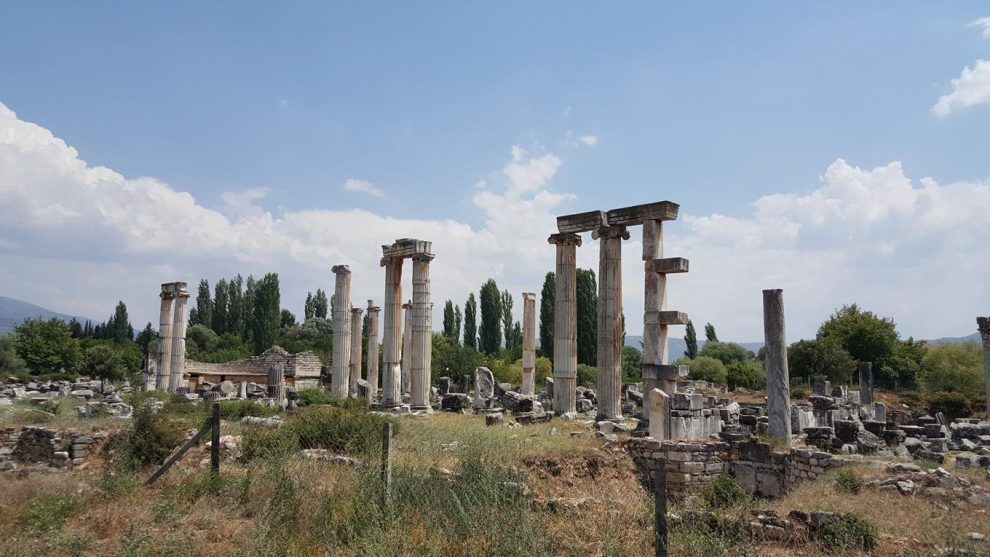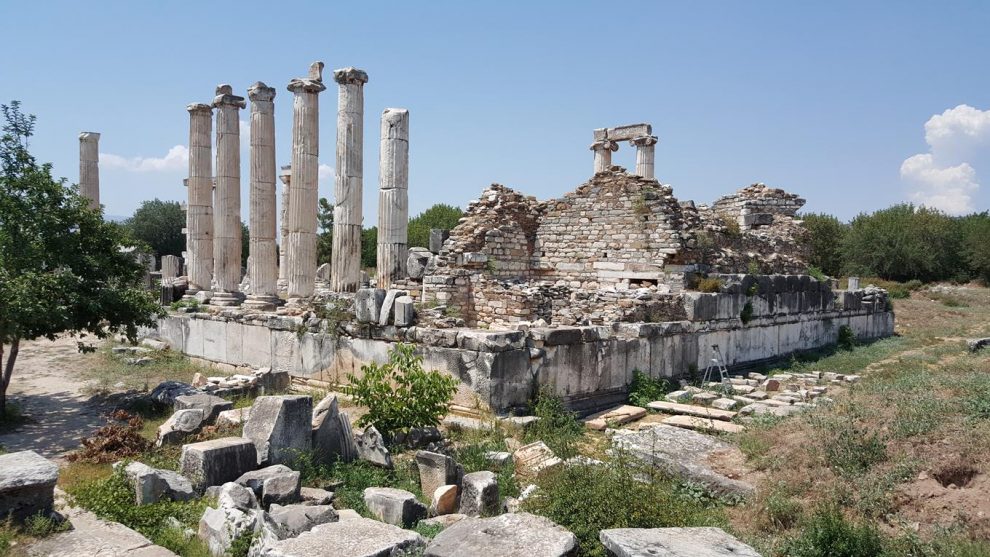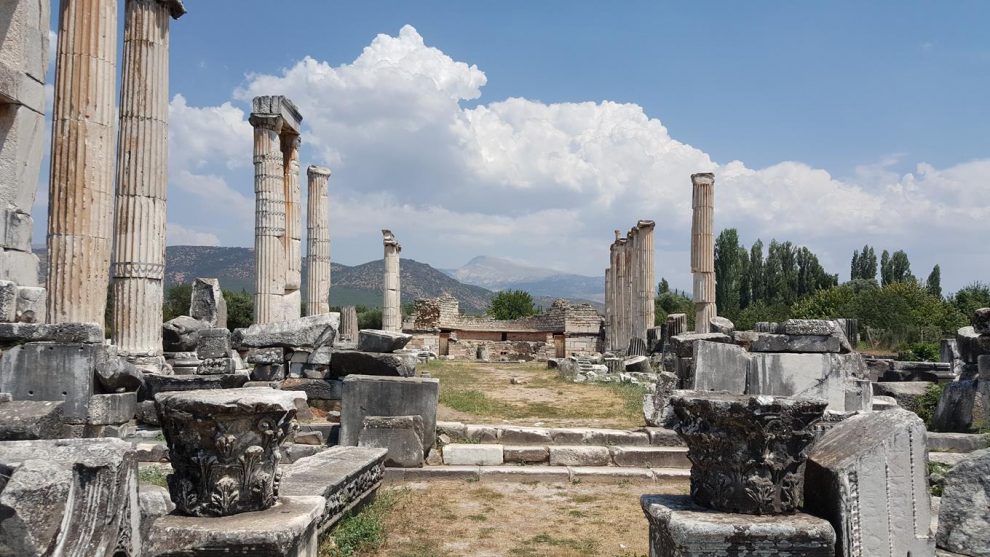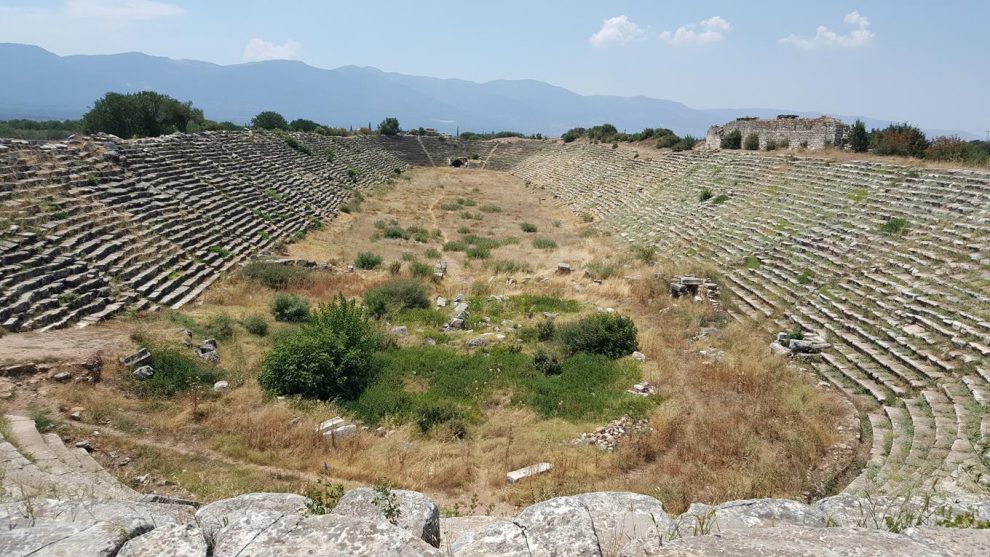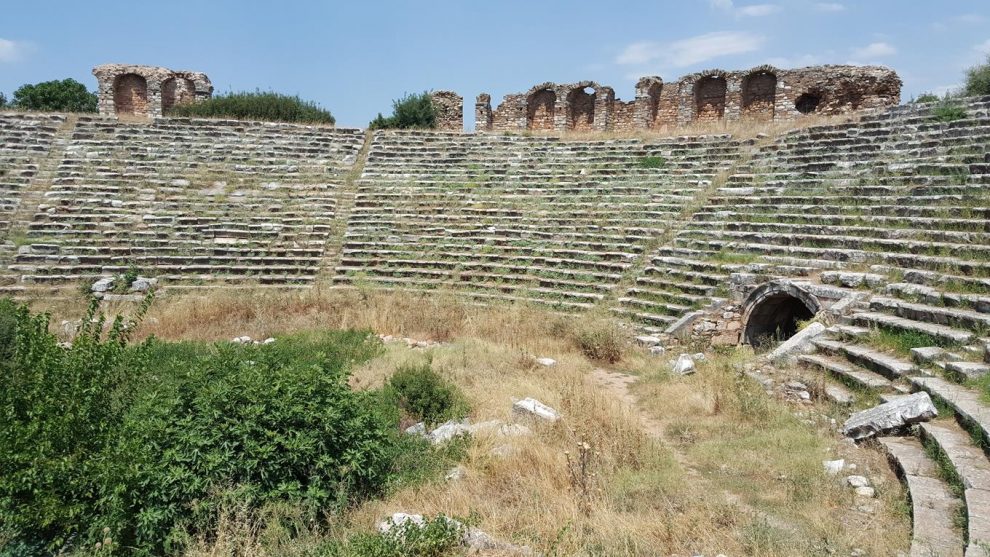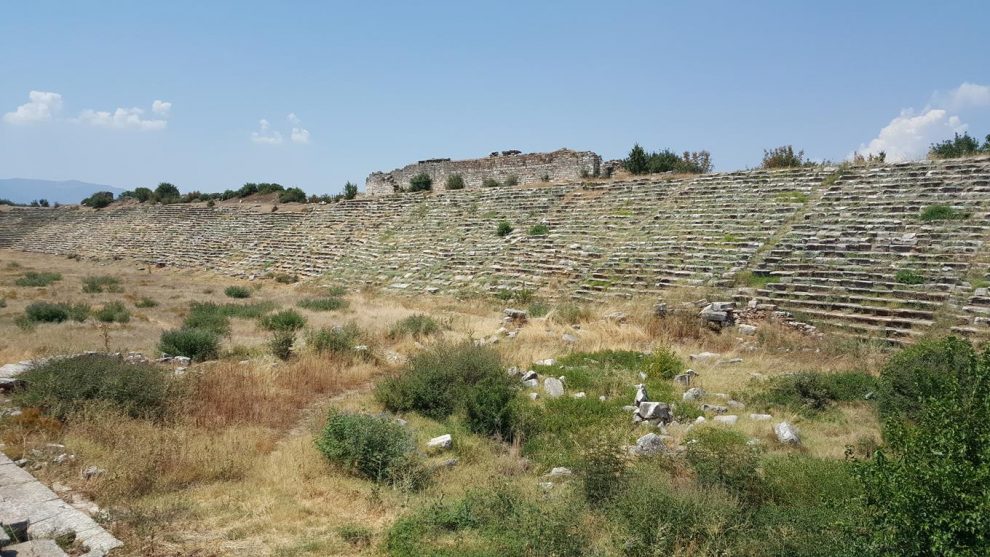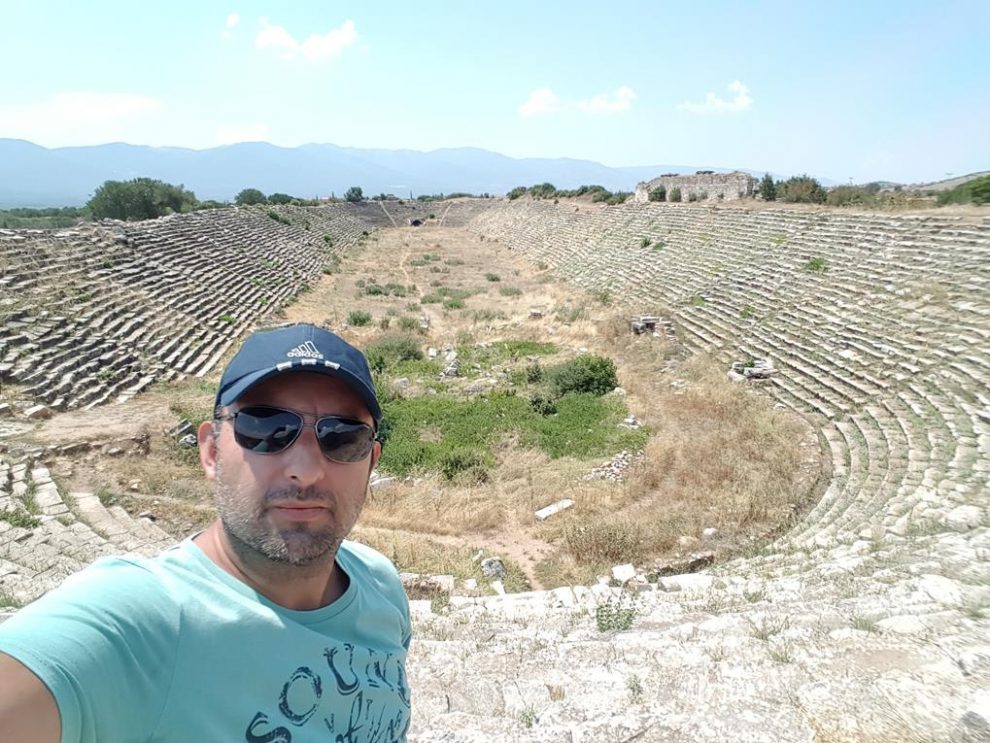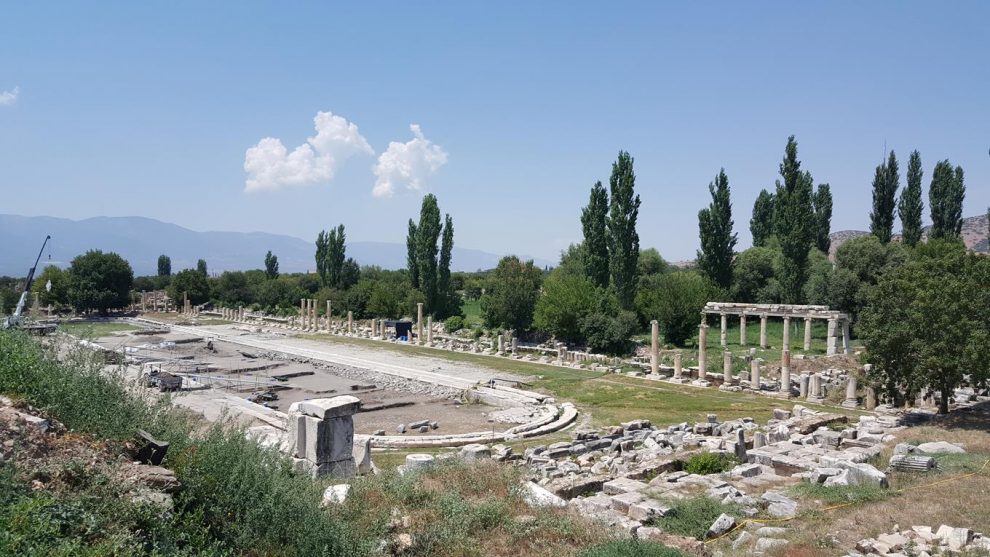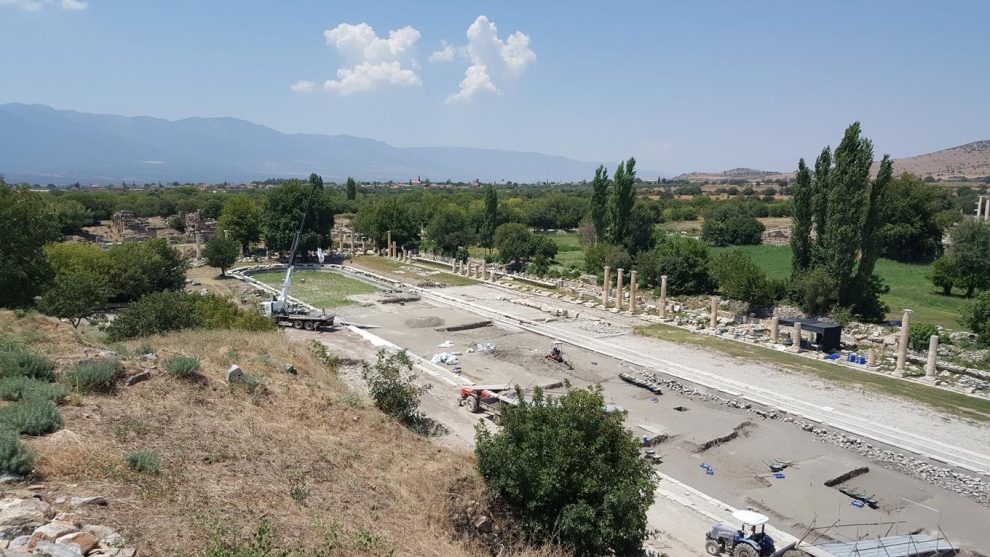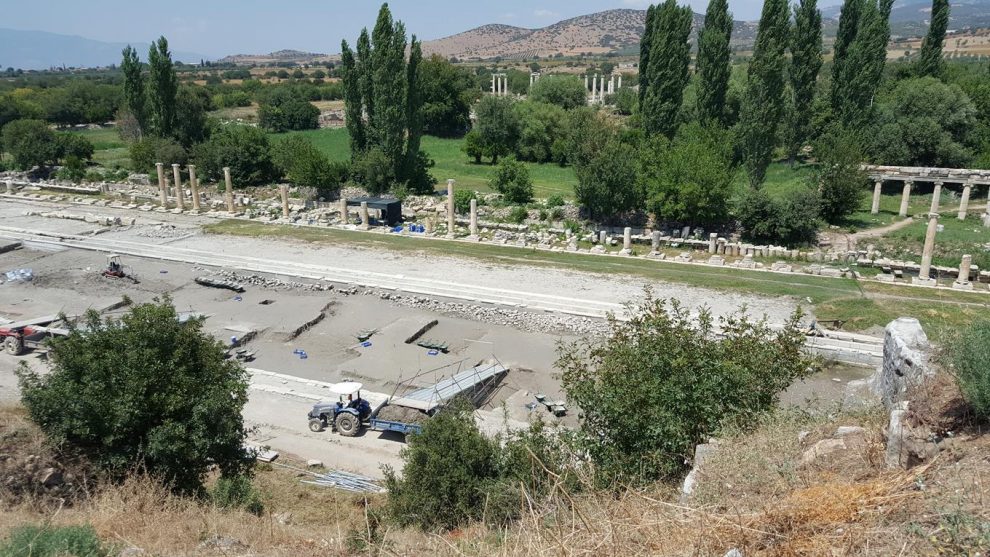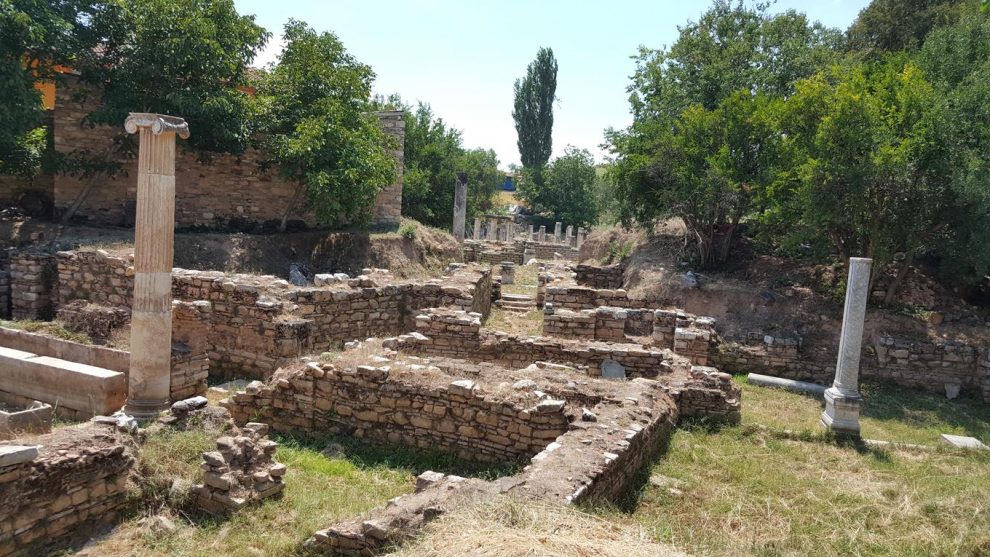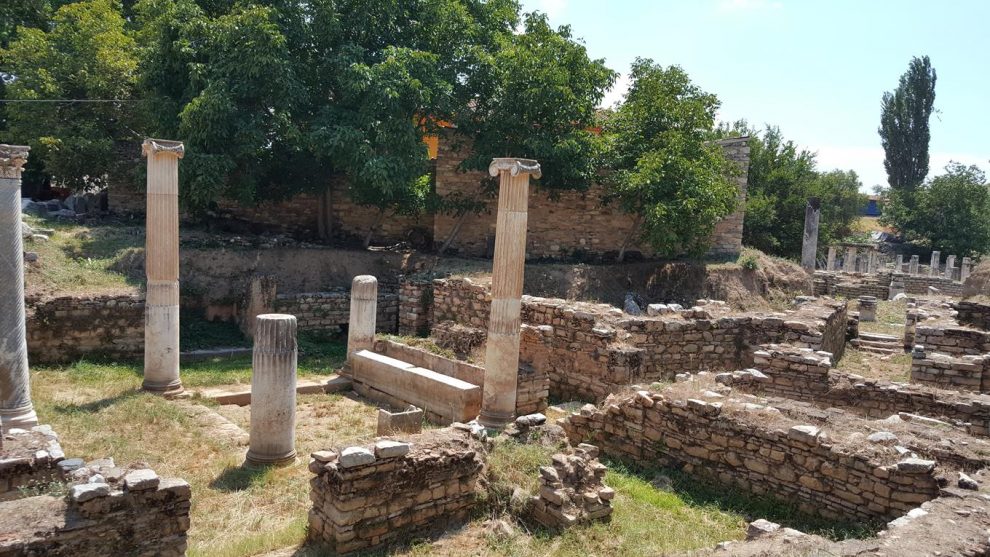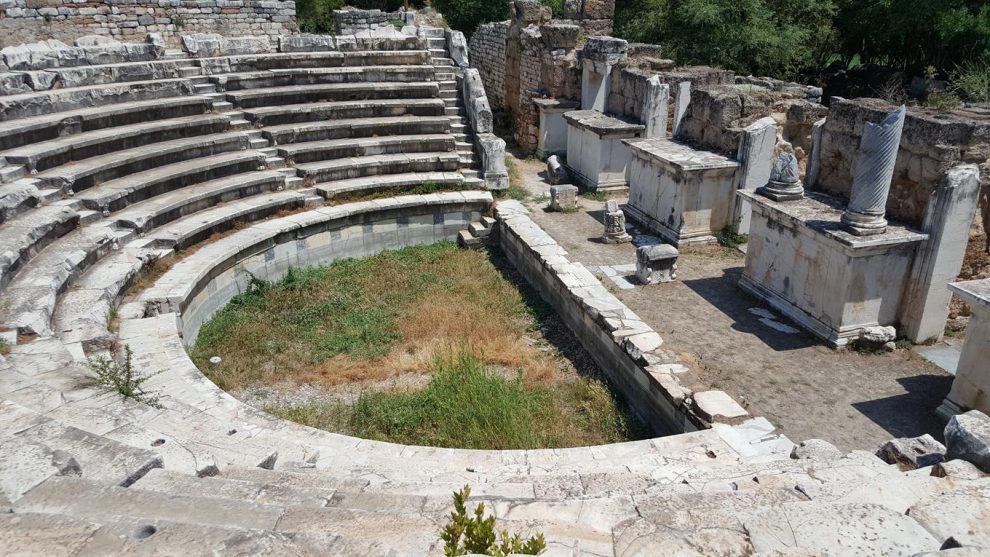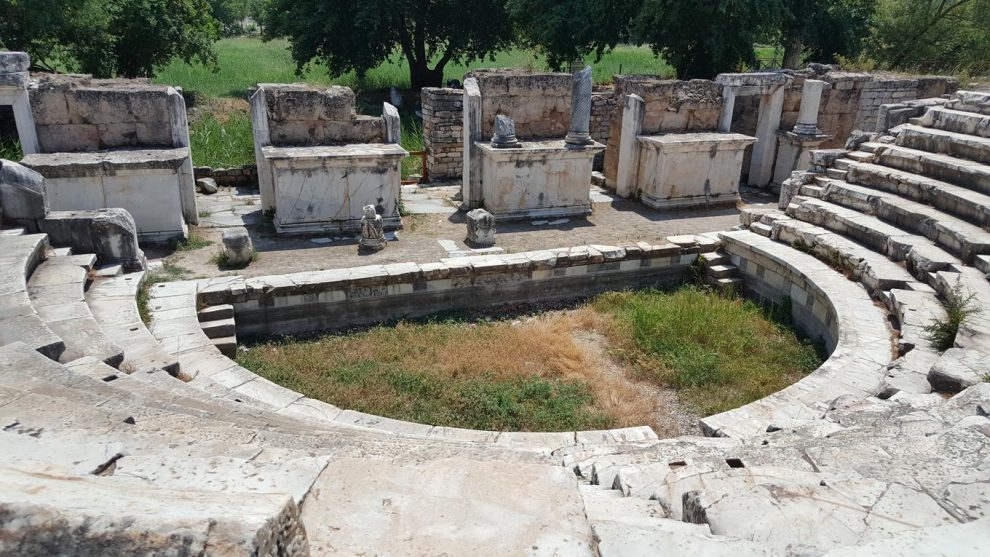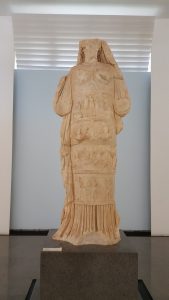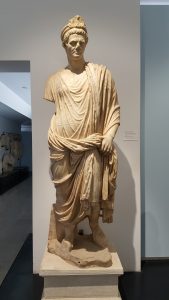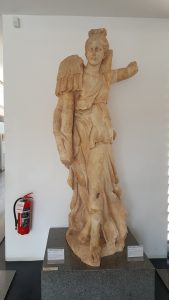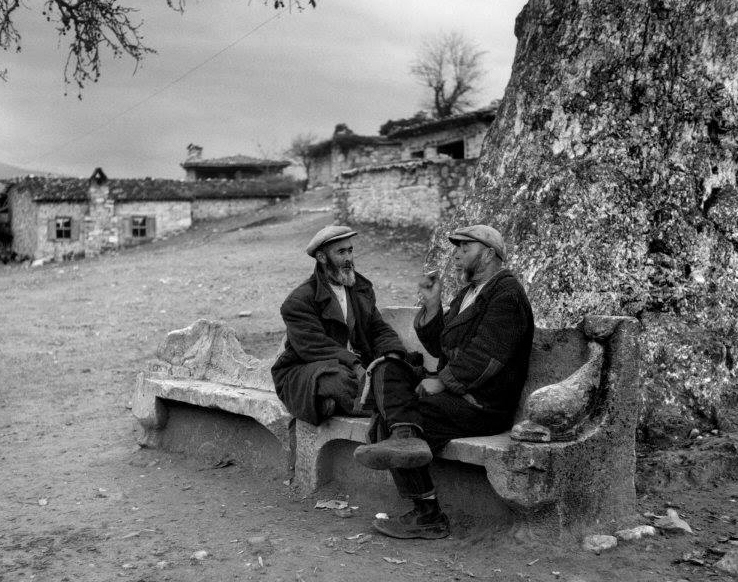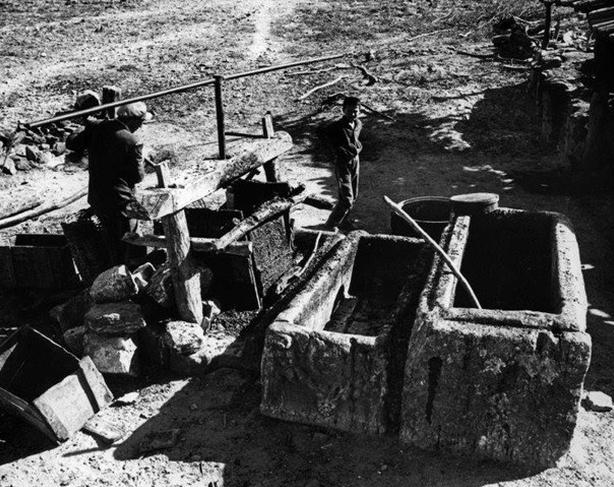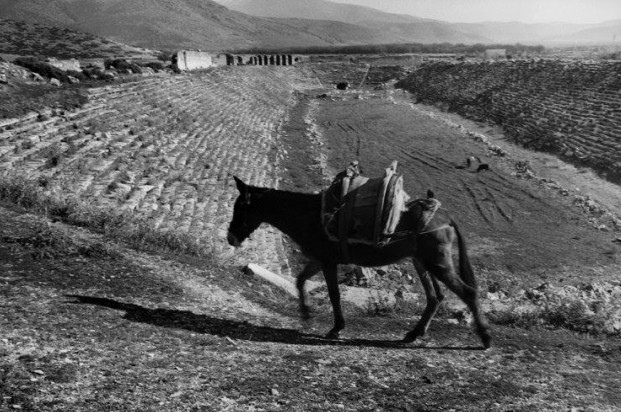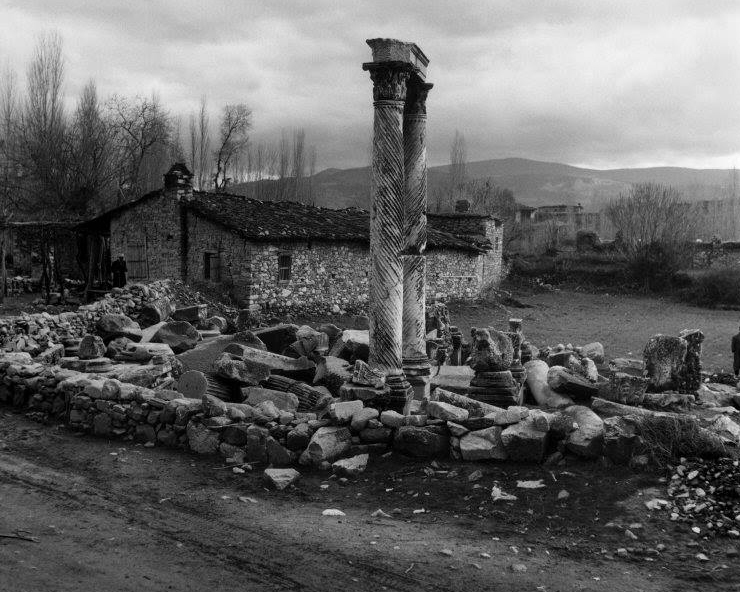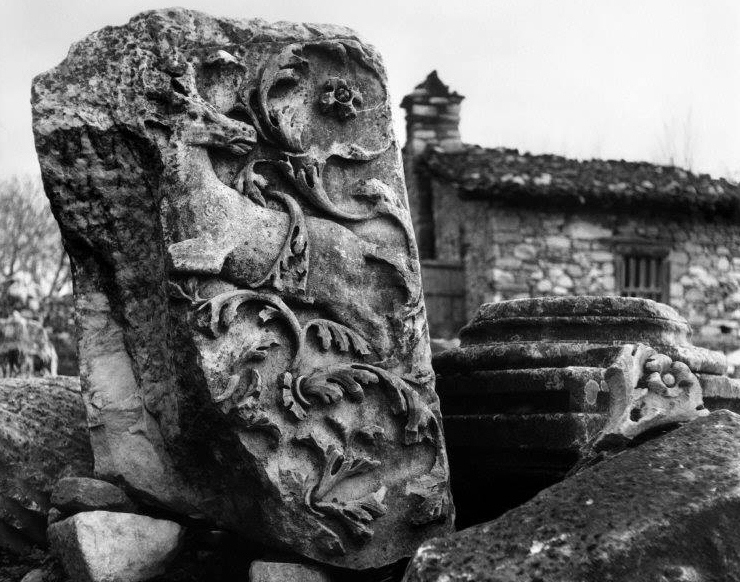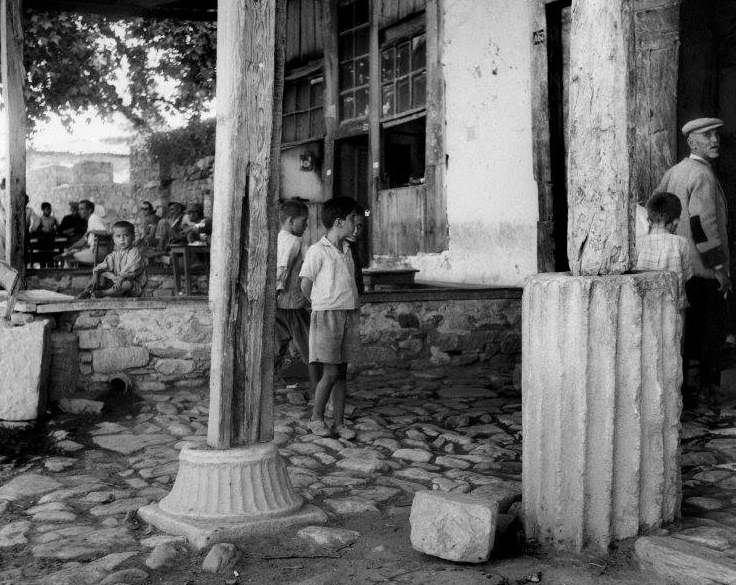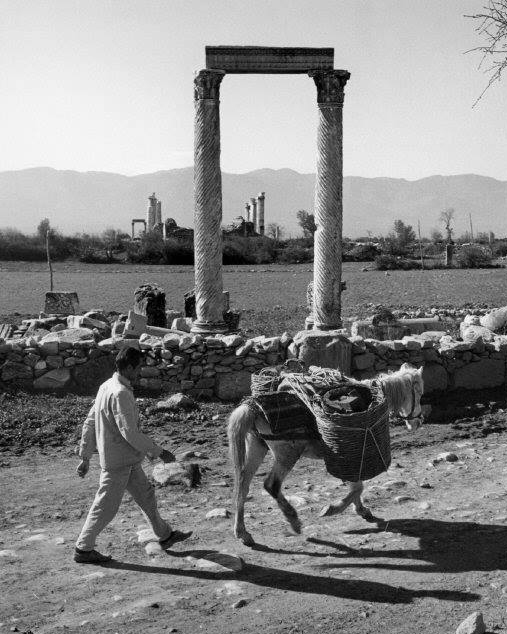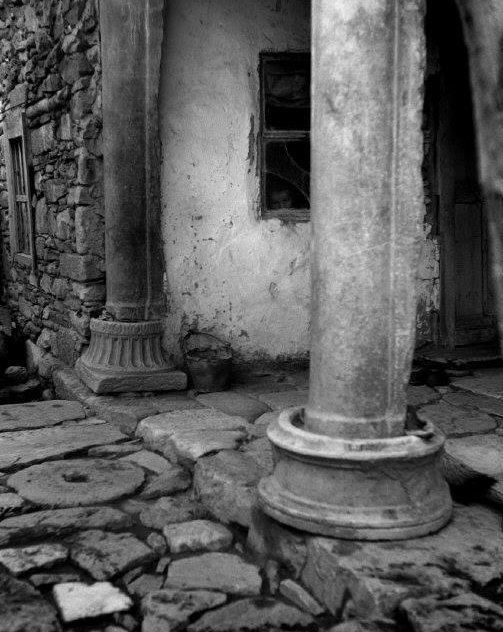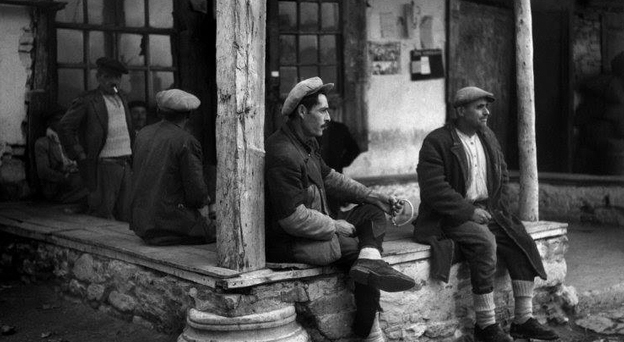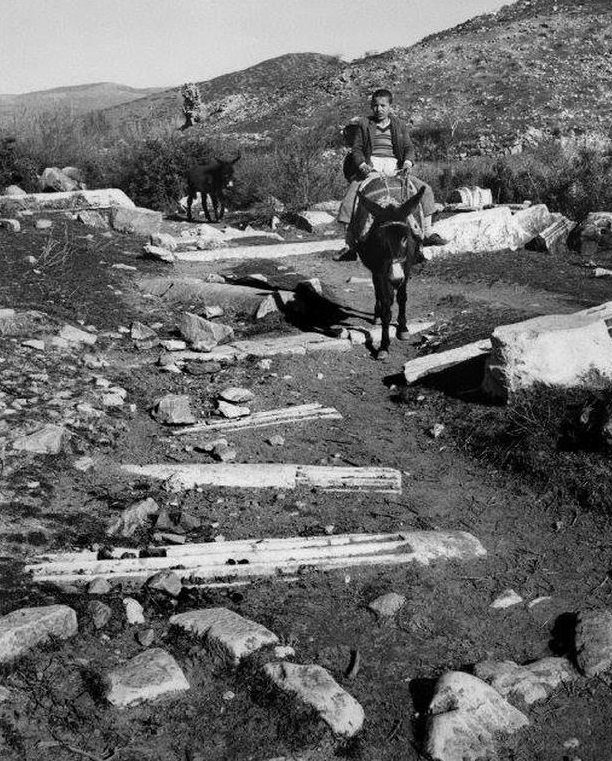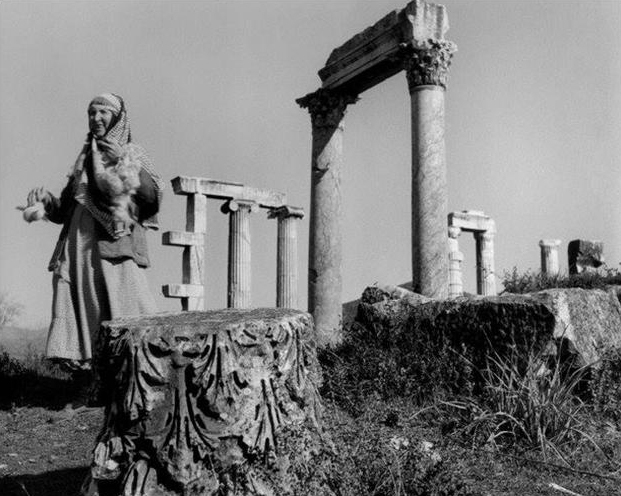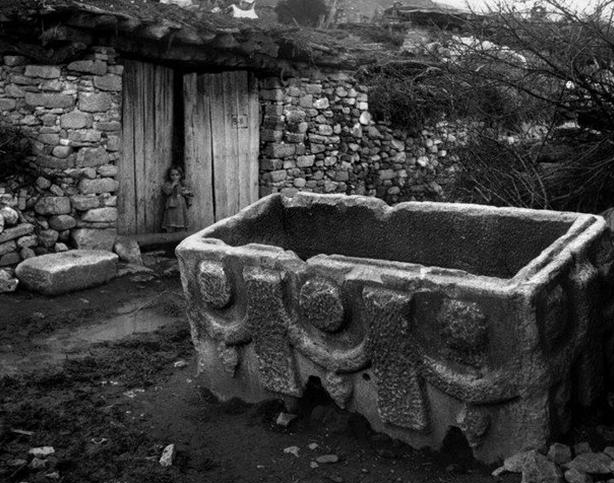Aphrodisias (Afrodisias); Aydın’ın, Karacasu ilçesinde, Geyre beldesi üzerinde bulunan Roma ve Eski Yunan dönemlerine ait antik kentlerden biridir. M.Ö. 2. yüzyıldan M.S. 6. yüzyıla kadar görkemini korumuş olan tarihi kent tanrıça Afrodit Tapınağı ile ünlüdür. Aphrodisias MÖ 6. yüzyılda ilk kurulduğunda küçük bir köydü.
Aphrodisias antik kent özellikle Roma döneminde heykelcilik okulları ile önemli bir yere sahipti. M.Ö. 1. yüzyılda Roma imparatoru olarak Augustus unvanını alacak olan Octavian tarafından “Tüm Asya’dan kendime bu kenti seçtim.” sözleriyle kişisel koruması altına alınan Aphrodisias MS 3. yüzyılın sonlarına doğru Roma İmparatorluğu’nun Karia Eyaleti’nin başkenti oldu. Daha sonra başkentin etrafı surlarla çevrildi.
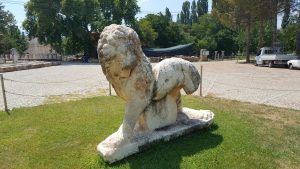 Tarihi kentte en çok stadyum ve Afrofit Tapınağı kutsal alanına girişi sağlayan Tören kapısı ile tanınmaktadır. Roma ve Eski Yunan dönemlerinde büyük çoğunluğu mermerden yapılan yapıt ve heykellerin günümüze kadar korunmuş olarak gelmesi Aphrodisias’ın önemini göz önüne sermektedir.
Tarihi kentte en çok stadyum ve Afrofit Tapınağı kutsal alanına girişi sağlayan Tören kapısı ile tanınmaktadır. Roma ve Eski Yunan dönemlerinde büyük çoğunluğu mermerden yapılan yapıt ve heykellerin günümüze kadar korunmuş olarak gelmesi Aphrodisias’ın önemini göz önüne sermektedir.
Polonya’nın Krakow şehrinde gerçekleşen UNESCO 41. Dünya Miras Komitesi Toplantısı’nda Aphrodisias Antik Kenti ve kenti kuzeydoğusunda bulunan antik mermer ocakları 2017 UNESCO Dünya Miras Listesine kaydedildi.
Aphrodisias antik kent ziyaretçilere her gün açıktır. Sadece ören yeri ve müzeler dini bayramların birinci günü saat 13:00’e kadar kapalıdır.
Aphrodisias antik kenti biraz daha görsel olarak yakından tanıyalım…
Aphrodisias; It is one of the ancient cities of the Roman and Ancient Greek periods located in the Karacasu district of Aydin, on the Geyre province. B.C. From the 2nd century AD. It is famous for its temple of Aphrodite, the goddess of the ancient city, which has preserved its glory until the 6th century. Aphrodisias was a small village when it was first established in the 6th century BC.
The ancient city of Aphrodisias had an important place with sculpture schools especially during the Roman period. B.C. Aphrodisias under personal protection by the phrase “I have chosen this city from all of Asia” by Octavian who will take the title of Augustus as the Roman emperor in the 1st century AD was the capital of the Roman Empire’s Karia Province towards the end of the 3rd century AD. Later, the capital was surrounded by the city walls.
It is best known for its stadium and the ceremonial gate which provides access to the sanctuary of the Temple of Afrofit in the historical city. In the Roman and Ancient Greek era, the great majority of marble work and sculptures come to life as preserved as the daily Aphrodisias importance.
At the UNESCO World Heritage Committee meeting in Krakow, Poland, the Aphrodisias Ancient City and its ancient marble quarries in the north-east were registered on the UNESCO World Heritage List of 2017.
The ancient city of Aphrodisias is open every day to visitors. Only ruins and museums are closed until 13:00 on the first day of religious festivals.
Aphrodisias is a little more visually familiar to the ancient city …
![]()
* TETRAPYLON (Tören Kapısı)
Afrodit tapınağı kutsal alanına girişi sağlayan tören kapısı, M.S. 200 yılı civarında yapılmıştır. Bu kapı ile, Aphrodisias’ın Kuzey-Güney yönünde devam eden ana yolu, tapınağın önünde ki geniş avluya bağlanmıştır. Anıtsal yapının bilimsel verilere dayalı yeniden yapımı (rekonstrüksüyonu) 1991 yılında tamamlanmıştır.
Bu projenin gerçekleşmesi, yapının özgün mermer bloklarının %85 gibi çok büyük oranda korunarak günümüze ulaşmış olmasına bağlıdır. Yapının eski hali rekonstrüksüyon başlamadan önce dikkatli bir şekilde tamamen sökülerek yeni temeller üzerinde tekrar bir araya getirilmiştir.
Yapı yeniden ayağa kaldırılırken sütunları desteklemek amacı ile çelik çubuklar ve diğer destek elemanları kullanılmış, ayrıca gerekli yerlere özgün parçalardan kalıplar yardımıyla dökülen beton bloklar yerleştirilmiştir.
The monumental gateway to the Sanctuary of Aphrodite was built in ca. A.D. 200. It led from Aphrodisias’s main north-south street into a large forecourt in front of the Temple. Acomplete scientific reconstruction, or anastylosis, of the gateway was completed in 1991.
This reconstruction was made possible by the extraordinary preservation of the structure – 85% of its original marble blocks survive. Before reconstruction, the standing ruins were dismantled, and new foundations were laid.
The gateway was then painstakingly reassembled, incorporating steel reinforcing bars in the columns and other structural elements, and adding new cast-concrete elements where necessary.
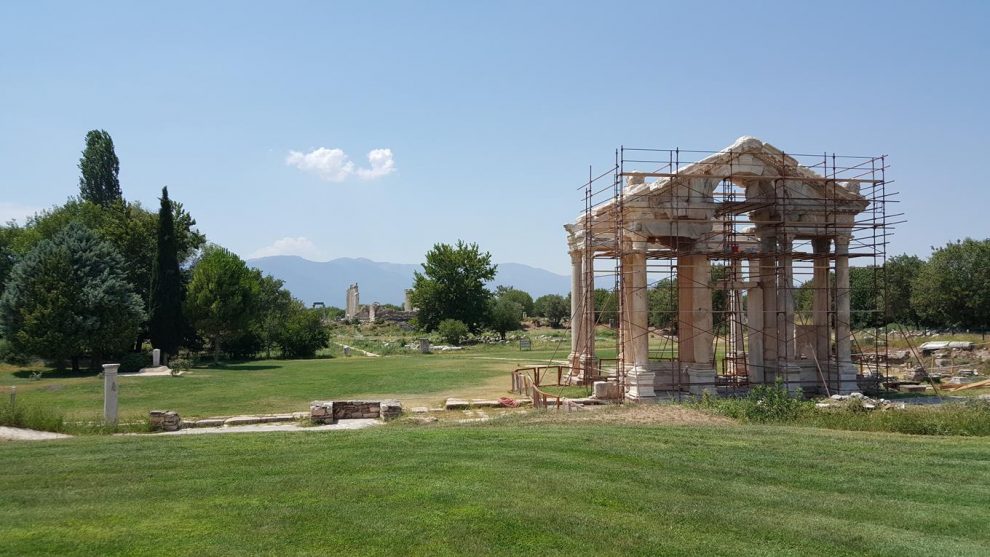
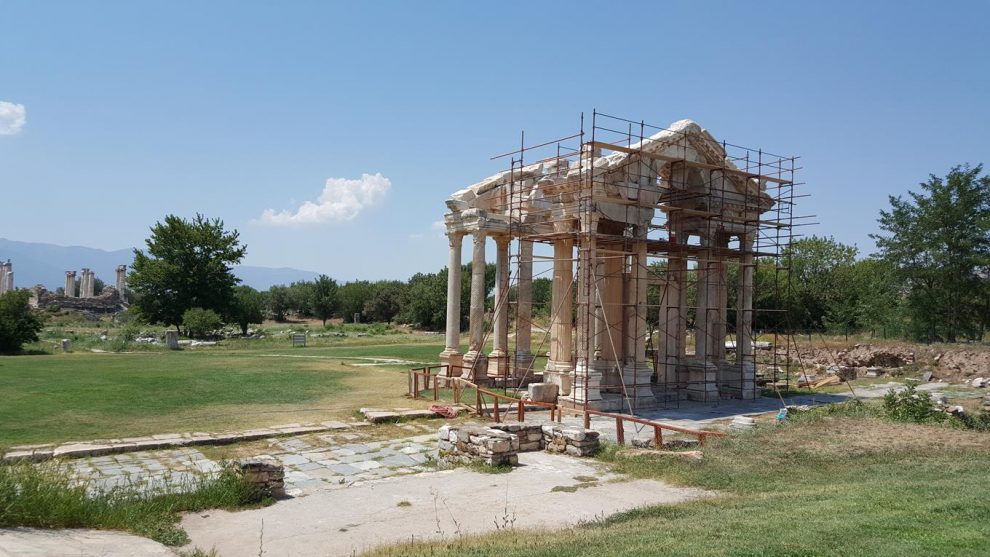
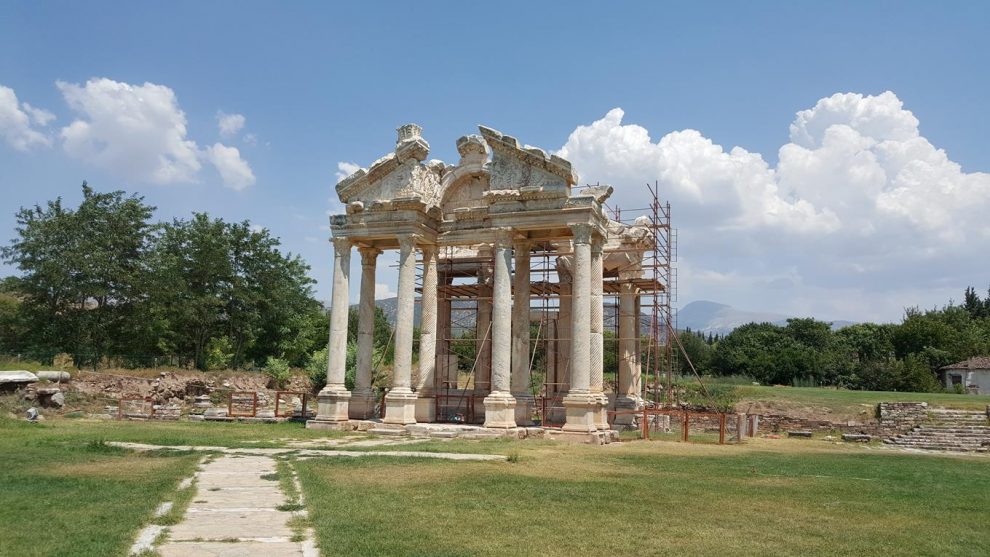
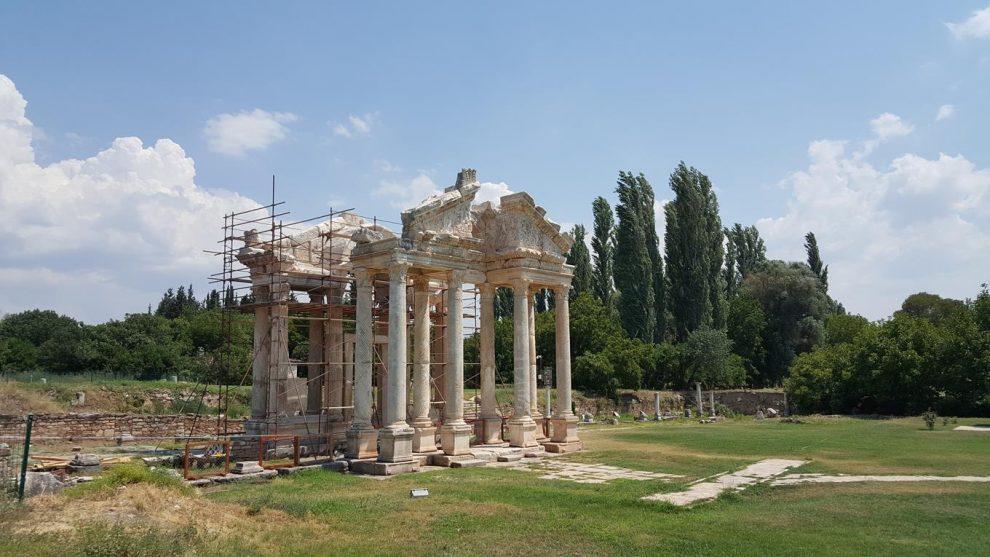
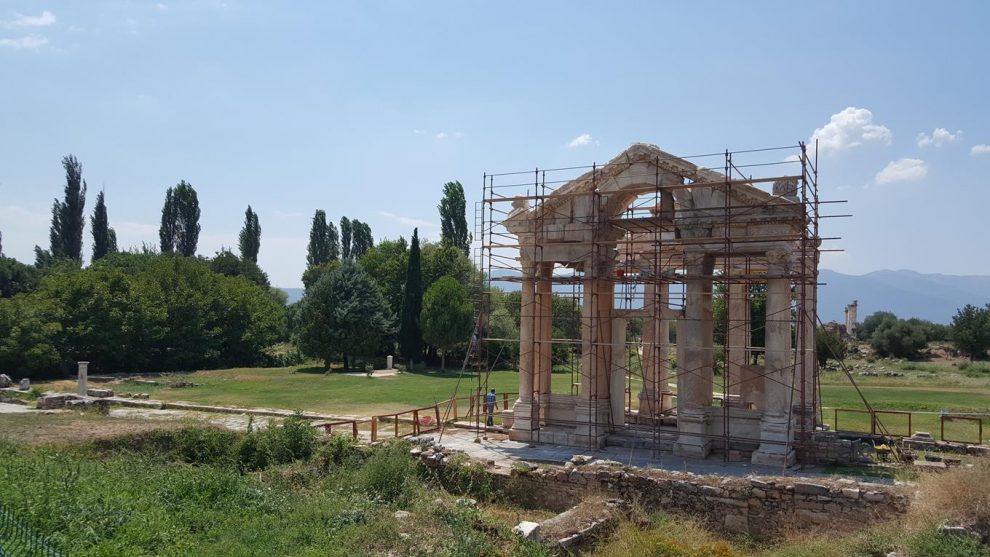
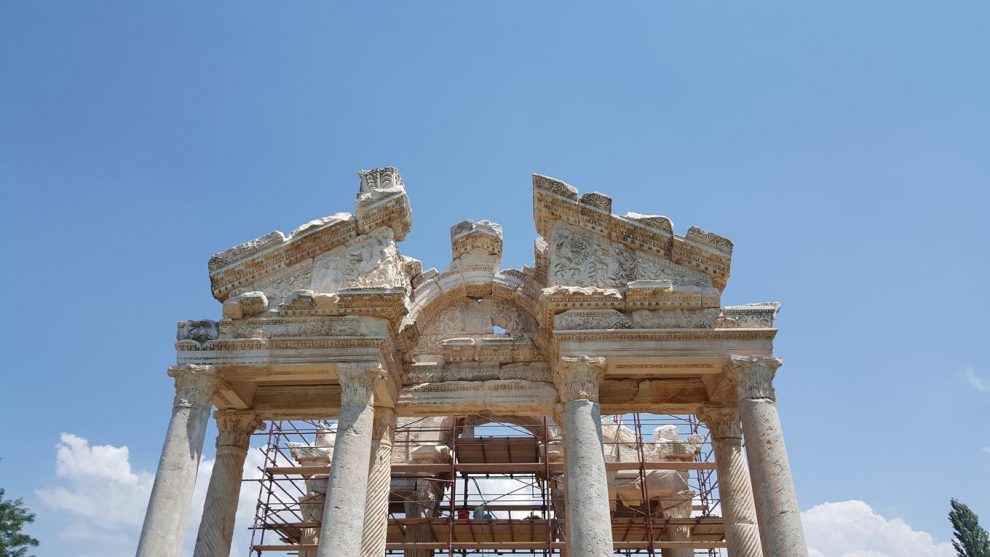
![]()
* SEBASTEİON (Tapınak)
Roma İmparatorluğu’nun Yunanca konuşulan bölgelerinde oldukça sık rastlanan bir uygulamaya göre Roma imparatorlarına Tanrı olarak tapınılmakta idi. Sebasteion bu amaçla kullanılmış diniz bir yapıdır. Yapının ana bölümleri tapınak ve uzun bir açık avludan oluşur.
Avlunun her iki yanında üç katlı sütunlu birer yapı bulunmaktadır. İkinci ve üçüncü katlarda ki sütunların arasında insan boyutlarında kabartma heykeller yeralmaktadır. 1970 ‘lerin sonlarında yapılan kazılarda 190 orijinal kabartmadan 70 ‘den fazlası bina yıkıldığında düştükleri hali ile bulunmuştur.
The Sebasteion was a religious sanctuary dedicated to the worship of the Roman emperors as gods – a widespread practice in the Greek-speaking parts of the Roman empire. The main components of the sanctuary were a temple and a long courtyard.
The courtyard was flanked by triple-storied portico-like buildings. The speces between the columns of the second and third storeys of these buildings were filled with lifesize relief sculptures. During excavation in the late 1970s, more than 70 of the original 190 of these reliefs were found lying where they had fallen when the buildings collapsed.
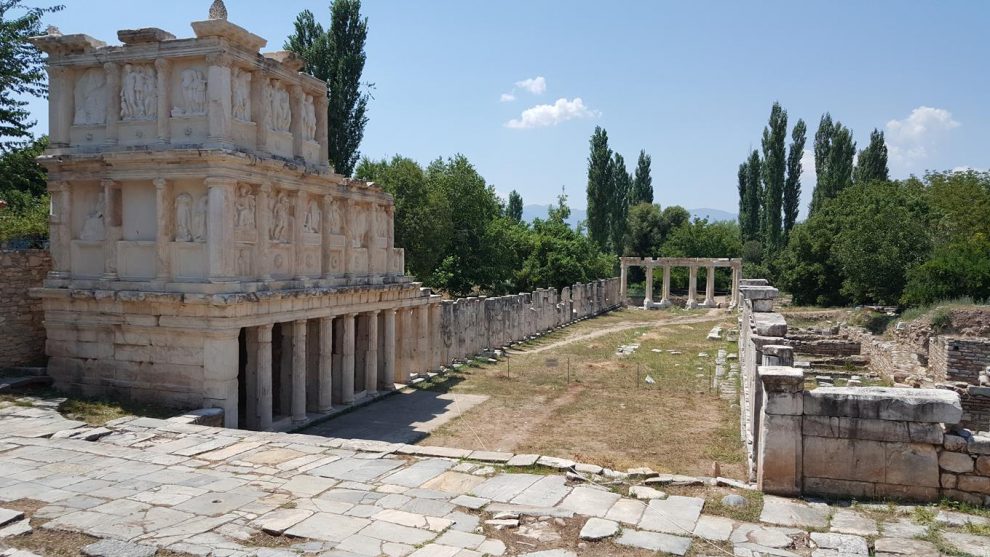
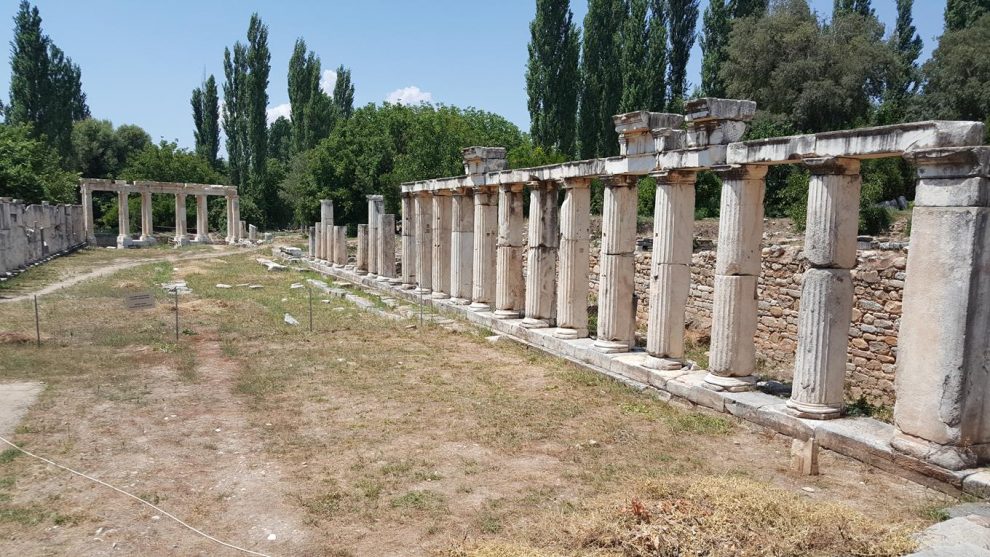
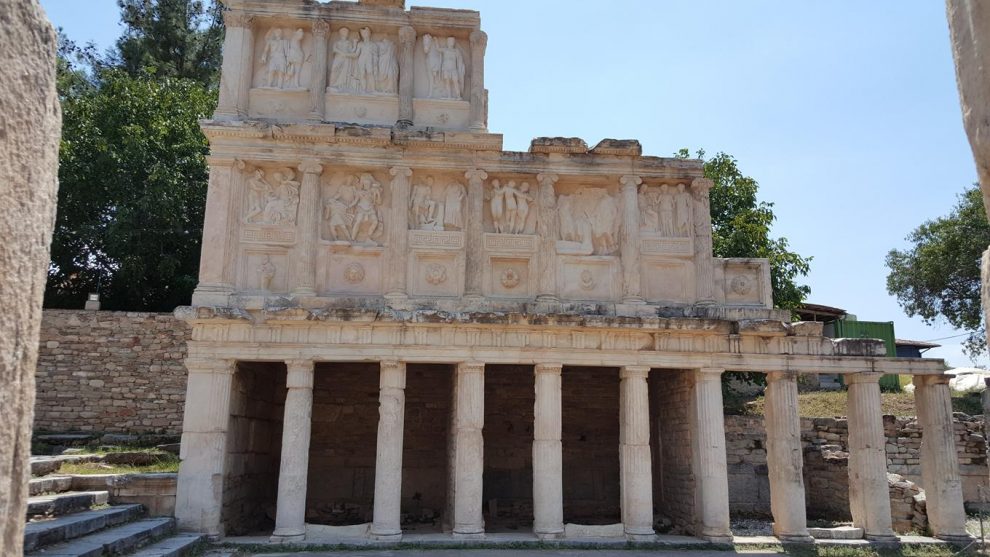
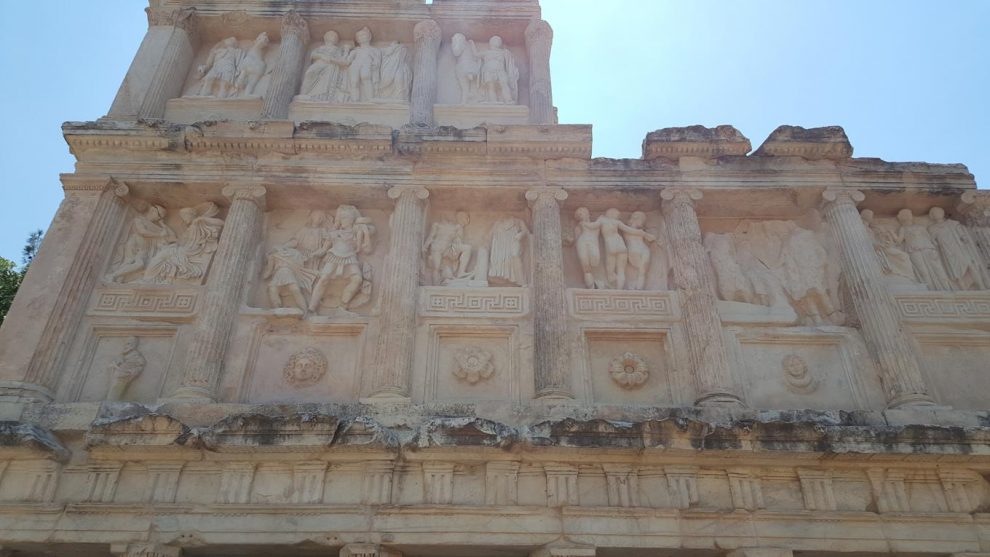
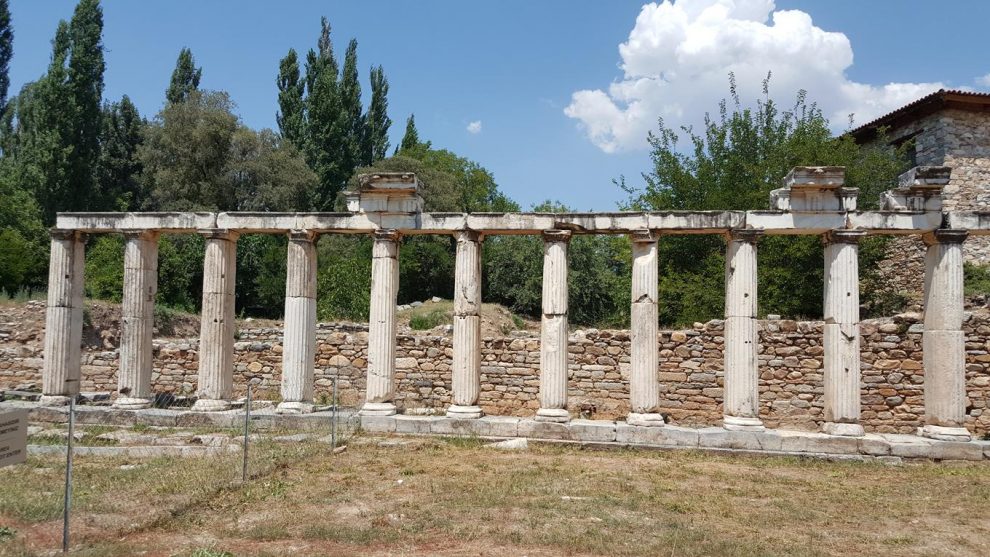
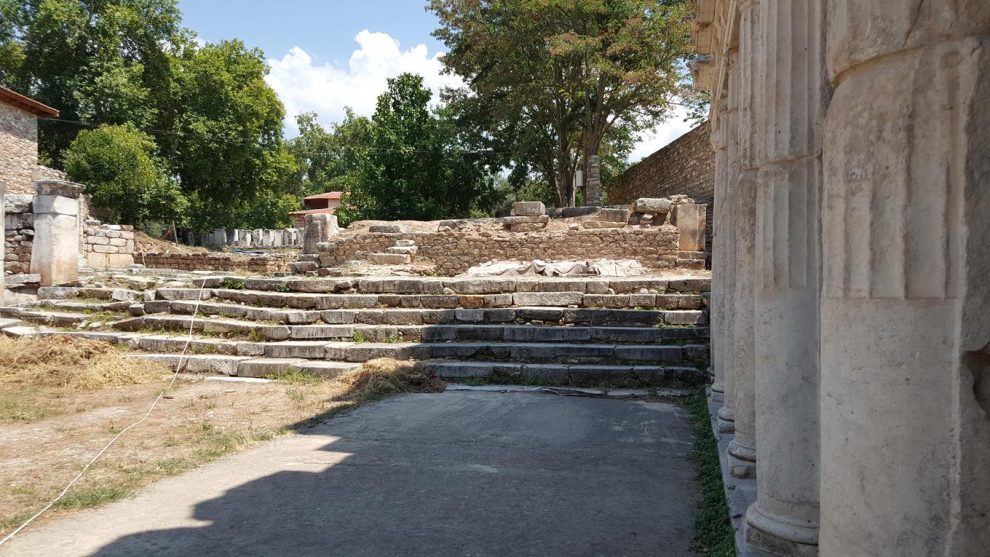
![]()
* APHRODİTE (Afrodit) TAPINAĞI
Aphrodite Tapınağı’nın yapımına M.Ö. 1. yüzyılın sonlarında başlanmıştır. Yapının masraflarını, Agora ve Tiyatroyu da yaptıran ve şehrin önemli kişileri arasında yer alan Zoilos adlı kişi karşılamıştır. M.S. 2. yüzyılda tapınağın çevresinde ki alan, doğuda ki iki katlı sütunlu bir cephe ile, kuzey, güney ve batıda ise sütunlu bir bölümle (portiko) çevrelenmiştir. Tapınak yaklaşık M.S. 500 yılında kiliseye çevrilmiş ve bu yeni kullanım ile beraber çok geniş bir mimari yenileme programına başlanmıştır.
Tapınağın doğu ve batı uçlarında ki sütunlar yerlerinden alınarak kuzey ve güneydeki sütun sıralarına eklenmiş, iç kısımdaki yapı taşları da yapıyı dört yandan çevreleyen yeni duvarların yapımında kullanılmıştır.
Bu yolla yapı tapınaktan daha büyük, bazilika planlı bir kilise, haline dönüştürülmüştür.
Yapının kilise olarak kullanımı 12. yüzyıl sonlarında bölgenin Selçuklu kontrolü altına geçişine kadar devam etmiştir.
The Temple of Aphrodite was begun in the late first century B.C. The initial construction was paid for by Zoilos, a leading citizen who also sponsored the construction of the Agora and Theater. In the second century A.D., the temple was enclosed in an elaborate colonnaded court, framed by a two-storied columnar façade on the east, and by porticos on the north, west and south. Around A.D. 500, the temple was converted into a Christian church.
The conversion was an enormous undertaking, in which the columns of the east and west ends of the temple were moved from their original positions and used to extend the north and south colonnades.
The interior of the temple was also dismantled, and the stone was reused in the construction of new walls enclosing the building on all sides.
In this way, the building was converted into a church of basilical plan, much larger than the pagan temple it replaced. The church remained in use until the Seljuk conquest of the region aroun Aphrodisias in about A.D. 1200.
![]()
* STADYUM (Stadium)
Afrodisias stadyumu 270 metre uzunluğu, 30.000 kişiyi alabilecek otuz sıralık oturma bölümü ile, dünyanın en iyi korunmuş antik stadyumu olmasının yanı sıra en büyüklerinden de birisidir. Yapı M.S. 1. yüzyılda koşu, uzun atlama, disk ve cirit atma, güreş gibi geleneksel Yunan spor yarışmaları için kullanılmıştır. Stadyum aynı zamanda gladyatör (zırhlı sporcu) ve vahşi hayvan mücadeleleri amacıyla da kullanılmıştır.
Yaklaşık M.S. 400’de yapının doğu tarafı, içinde Roma usulü kan dökülen, vahşi sporların yapıldığı bir arenaya (gösteri alanı) dönüştürülmüştür. Stadyumun oturma sıraları üzerine kazınan pek çok yazıt, stadyumu dolduran kişiler hakkında pek çok ilginç bilgi vermektedir.
Örneğin dericiler ve kuyumcular gibi meslek guruplarına ayrılan alanlar olduğu gibi hem kadın hem erkek, belirli kişilere ayrılmış oturma yerlerinin de bulunduğu anlaşılmaktadır. Afrodisias’ın yerli halkının oturduğu özel yerlerin yanı sıra Menderes Antakyası (bugünkü Başaran) ve büyük olasılıkla Milet gibi diğer çevre şehirlerden gelen insanlar için de stadyum da belirli alanlar ayrılmıştır.
The Stadium at Aphrodisias is 270 meters long and had 30 tiers of seating with space for 30.000 people, making it not only the best preserved ancient stadium in the world bur also one of the largest. It was built in the first century A.D. to house traditional Greek athletic contests such as foot races, long-jumping, wrestling, discus, and javelin throwing.
The stadium was also used for gladiatorial combats and wild-beast fights, and in ca. A.D. 400, the east end of the building was turned into an arena specifically designed for Roman-style entertainments of this kind. Numerous inscriptions carved on the seats of the stadium provide interesting information about the ancient spectators.
The inscriptions reserved space both for groups such as the goldsmiths, and for specific individuals, including both men and women, and citizens nor only of Aphrodisias but also of other towns such as nearby Antioch on the Maeander (modern Başaran).
![]()
* PAZAR YERİ (Agora)
Odeonun güneyinde yer alan Agora’nın yapımına M.Ö. 1. yüzyılda başlanmıştır. Yapının etrafı tamamen sütunlarla çevrili olup doğu ve batı köşelerindeki iyon tarzı başlıklar taşıyan sütunların bazıları günümüzde ayakta durmaktadır. Pazar yerine net şekilde tiyatronun üzerinden bakılabilir. Doğu-Batı yönünde 150-200 metre mesafede iyon tarzında iki uzun portikodan oluşan sütunlu bir giriş vardır.
Kuzey ve güzey tarafında bulunan portikodan güneyde ki sütunlu girişe Tiberius’un girişide denilmektedir. Agora aynı zamanda toplantı yeri olarak kullanılmıştır. Agora’nın doğu tarafında bulunan alan iki katlı, sütunlu, nişli agora kapısı, M.S. 2. yüzyılın sonlarına doğru yapılmıştır.
Kapının her iki tarafında tonozlu iki tünel yer almaktadır. M.S. 5. yüzyıl başlarında Agora’yı sel baskınlarından korumak amacıyla bu kapı daha sonra bir çeşmeye (nympheum) dönüştürüldü. Çeşmenin önüne bir havuz yapılarak suların buraya akması sağlandı.
The construction of the Agora in the south of the Odeon It started in the 1st century. The building is surrounded entirely by pillars and some of the pillars bearing the ion-style headings on the eastern and western corners are still standing today. Instead of the market, it can be viewed clearly on the theater. In the east-west direction, there is a columned entrance which consists of two long porticoes in the form of ions at a distance of 150-200 meters.
The portico on the northern and southern side is called the entrance of Tiberius in the south with the columned entrance. The agora was also used as a meeting place. The area on the eastern side of Agora is a two-storey, columned, niche agora gate, M.S. It was made towards the end of the 2nd century.
There are two vaulted tunnels on either side of the door. A.D. At the beginning of the 5th century this gate was later converted into a nympheum in order to protect the Agora from floods. A pool was built in front of the fountain so that the waters flowed here.
![]()
* TİYATRO ve TİYATRO HAMAMLARI (Theatre and Theatre Baths)
Tiyatro binası hem gösteriler için hem de halkın toplanma yeri olarak kullanılmıştır. Yaklaşık 7000 kişilik bir oturma kapasitesine sahip bina, iki ana bölümden oluşmaktaydı. Seyirci kısmı tarih öncesi yerleşimine ait bir tepeye sırtını dayamıştı. Bunun önünde ise üç katlı ve mermerden yapılmış gösterişli sahne binası yer almaktaydı.
Sahne binasının birinci katı, arşitrav üzerine yazılmış olan adak yazıtı ile birlikte yeniden ayağa kaldırılmıştır. Yazıtta, binayı yaptıran kişinin, kendisini ilk Roma imparatoru Augustus’un azatlı kölesi olarak tanıtan Gainus Julius Zoilos olduğu belirtilmiştir.
Zoilos olasılıkla Afrodisias’ın yerlisiydi ve belki de korsanlar tarafından kaçırılıp daha sonra Oktavian tarafından satın alınmış veya ona miras olarak kalmıştı. Daha sonra azat edilince, zengin ve başkentle güçlü ilişkileri bulunan biri olarak, memleketine geri dönmüştü. Zoilos Tiyatronun yanı sıra Agoranın (halka açık ana meydan) kuzey portikosunu ve Afrodit Tapınağı’nı da yaptırmıştır.
Tiyatronun 1970’lerdeki kazıları sırasında, sahne binasını süsleyen heykellerin çoğu oldukça iyi korunmuş vaziyette ortaya çıkarılmıştır. Bunlar arasında şu anda Afrodisias Müzesi’nde teşhirde bulunan Apollon, iki Musa (tanrıça heykeli), Demos (halkın kişileştirilmesi), iki boksör, pek çok Zafer heykeli ve Polykleitos tarzında yapılmış atlet heykellerini sayabiliriz.
The Theater was used both for dramatic performances and for public assemblies, It had an estimated seating capacity of 7000 persons. The two main components of the building are the auditorium, built up against a prehistoric settlement mound, and an elaborate three-storied marble stage buikling.
The first storey of the stage building has been reconstructed, together with the dedicatory inscription carved on the architrave (lintel course). The inscription records the name of the building patron, Gaius Julius Zoilus, and identifies him as a freed slave of Octavian Augustus, the first Roman emperor.
Zoilus was presumably a native of Aphrodisias who had been enslaved, possibly by pirates, the purchased or inherited by Octavian. Eventually freed, he retumed home a wealthy man with powerful connections in the capital. In addition to the Theater, he also paid for the construction of the north portico of the North Agora (the main public square) and the Temple of Aphrodite.
During the excavation of the Theater in the 1970s, much of the statuary that decorated the stage building was recovered in an excellent state of preservation, including figures of Apollo, two Muses, Demos (a personification of the People), two boxers, several Victories, and a Polykleitan athlete, all now on display in the Aphrodisias Museum.
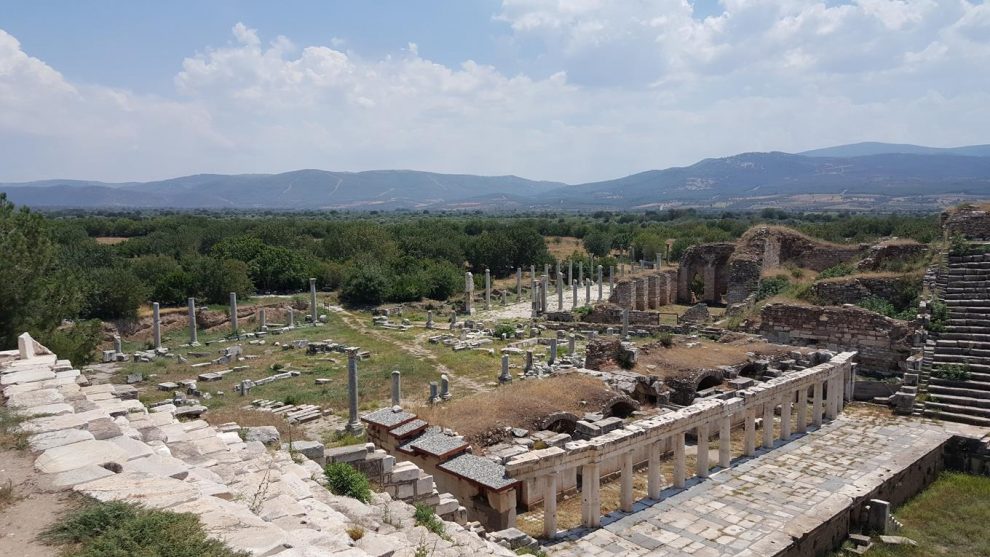
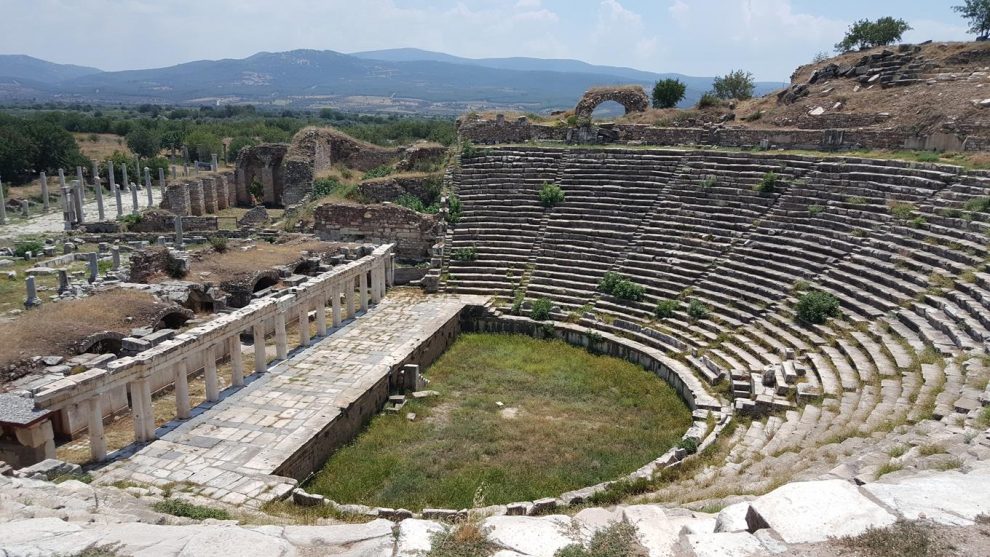
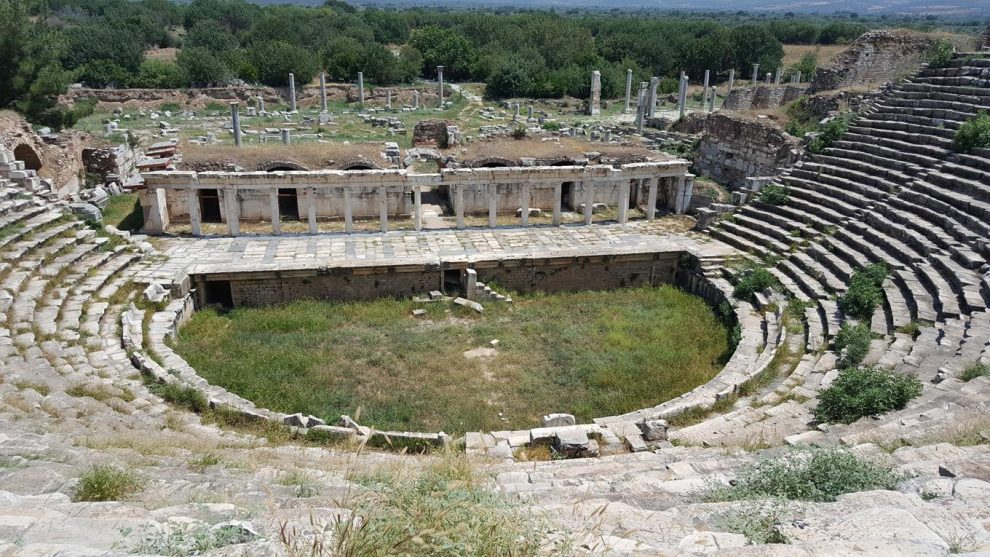
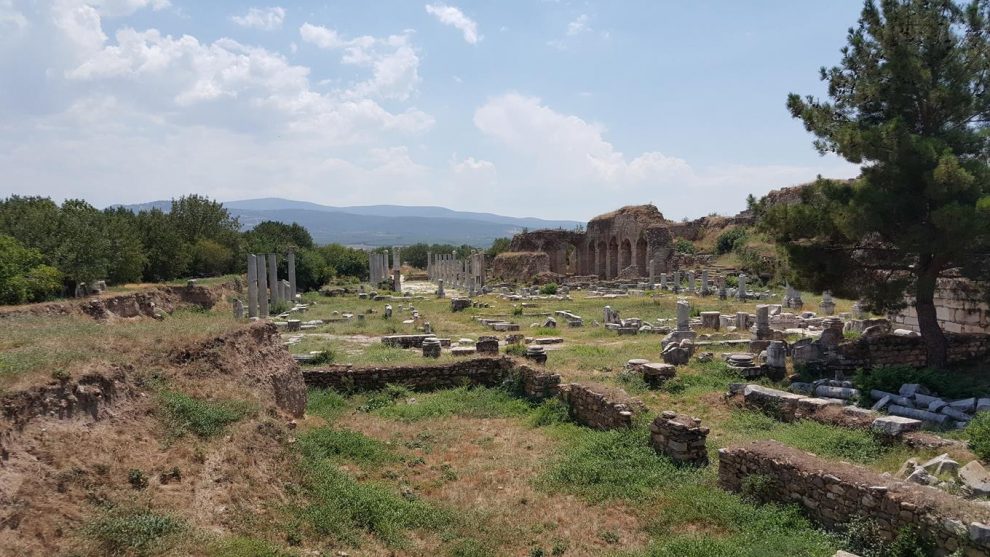
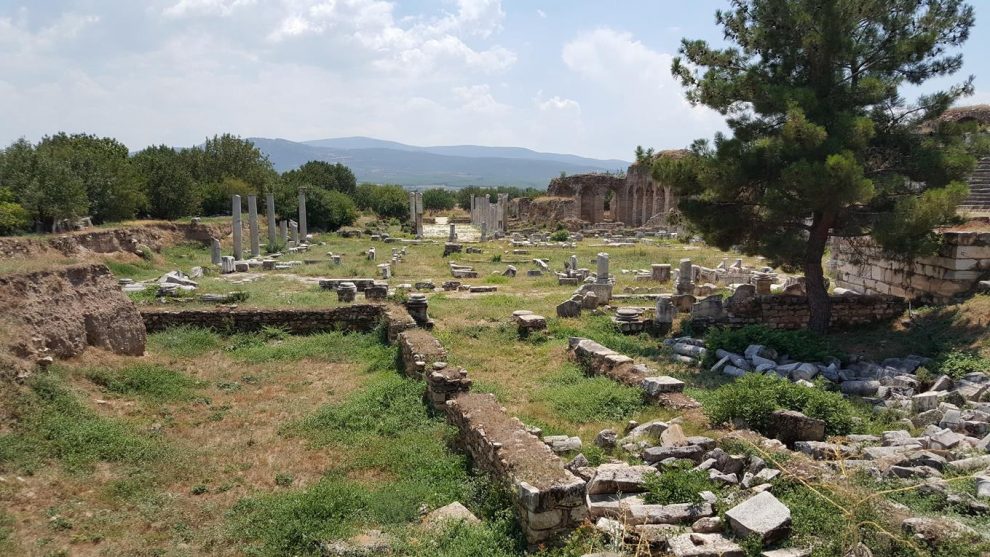
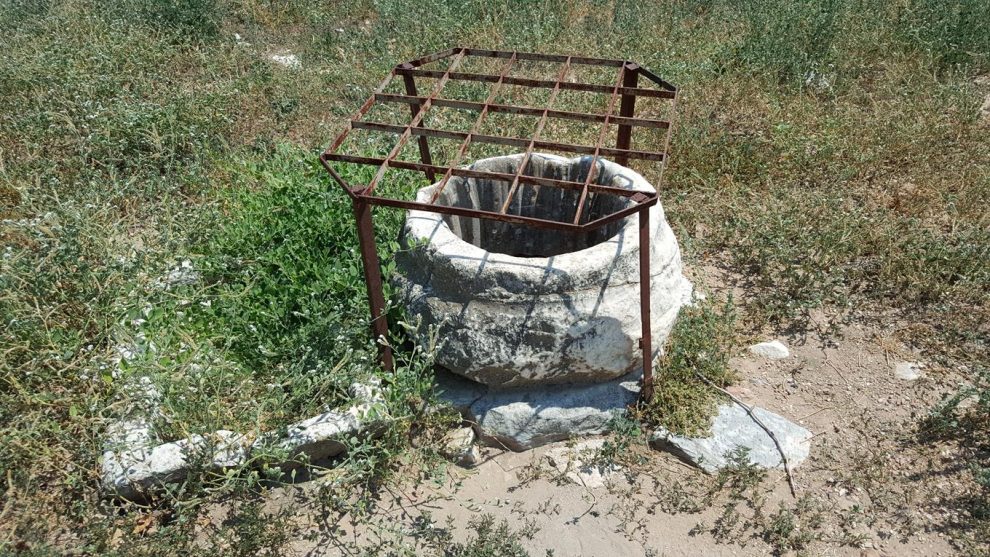
![]()
* MECLİS BİNASI ( Bouleuterion)
Bouleuterion (Meclis binası) Afrodisias’ın antik devirdeki şehir hayatında çok önemli bir yere sahipti. Bina şehrin yerel yönetimini sağlayan meclisin toplanma yeri olduğu gibi, kapalı tiyatro, konser salonu ve halkın toplanma yeri olarak da çok işlevli kullanılmıştır.
Mevcut yapı M.S. 200 yıllarında, halka açık ana meydan olan Kuzey Agoranın kuzey kenarında yapılmıştır. Bouleuterion’a Agoranın kuzey portikosundan girilmekte idi.
Bu oldukça yüksek, çift koridorlu portikonun eni 15 metre, uzunluğu da 200 metreden fazlaydı. M.Ö. 1. yüzyılın sonlarında inşa edilen yapı, daha sonra arka kapısından Bouleuterion’ beş ayrı giriş açmak amacıyla değişikliklere uğramıştır.
İki dış kapının yanında yerel bir hayırsever olan Dometeinos‘un ve onun yeğeni Tatiana’nın portre heykelleri bulunmaktaydı. Her iki heykel de yazıtlı kaidelerinin önünde bulunmuştur. Kaideler hala orijinal yerlerinde durmaktadır. Heykeller ise Afrodisias Müsesi’nde teşhir edilmektedir.
The’ Bouleuterion (Council House) was central to the civic life of Aphrodisias in antiquity. Like a modern town hall, it served both as the meeting place of the city’s administrative council (the Boule), and as a multi-purpose indoor theater, concert hall, and public assembly space.
The surviving building was constructed in about A.D. 200 on the north side of the North Agora, the main public square. The Bouleuterion was entered through the north portico of the Agora.
This was a lofty, double-aisled hall, 15 m wide from back to front and over 200 m long, erected in the late first century B.C. The building was later modified to provide access to the Bouleuterion through five doorways in its back wall.
Flanking the outer two doorways were portrait statues of a local benefactor called Dometeinos (on the west), and his niece Tatiana (on the east). Both figures were found lying in front of their inscribed pedestals. The pedestals remain in their original positions, and the statues are now exhibited in the Aphrodisias Museum.
![]()
* HEYKELTRAŞ ATÖLYESİ (The Sculptor’s Workshop)
Milattan sonra 3. ve 4. yüzyıllarda Meclis Binası’nın arkasında bulunan alanda bir mermer atölyesi yer alıyordu. Kuzeybatıda bulunan ve gri mermerden eşikleri olan iki oda heykel depolamak için kullanılmış ve bu odaları birbirine bağlayan kapı aralığında üç adet keski bulunmuştur.
Yontma işi dışarıda, önde bulunan açık alanda yapılıyordu. Yapıdan tamamlanmış ve tamamlanmamış mermer heykeller ortaya çıkarılmıştır. Bunlar, atölyede hem mitolojik heykeller hem de güncel portreler yapıldığında işaret etmektedir. İki renkli siyah-beyaz mermerden yapılmış heykeller ise özel bir uzmanlık konusudur.
Bu tip heykeller, açık ve koyu renk mermerin belirgin bir damarda birleştiği bütün halindeki kütlelerden yontulmuşlardır. Atölyede eski heykeller de tamir edilmiş ve yenilenmiştir. Ayrıca, çırak heykeltraşların burada eğitildiğine dair kanıtlar vardır. Atölyeden çıkarılan heykeller, heykelcikler ve aletler Aphrodisias Müzesi’nde sergilenmektedir.
The area behind the Council House was occupied in the third and fourth centuries AD by a marble workshop. Two rooms at the north-west (with gray marble thresholds) were used for storing sculpture, and three chisels were found in the doorway connecting them.
Carving took place outside, in the open yard in front. Both finished and unfinished marble figures were excavated in the complex, and they show that the Workshop made both mythological statues and contemporary portraits. Bi-volored black-and-white marble statuettes were a distinctive specialty.
They are carved from single blocks in which light and dark marble join in a distinct seam. Old statues were also repaired and refurbished here, and there is evidence for the training of apprentice marble carvers. Statues, statuettes, and tools from the Workshop are displayed in the Aphrodisias Museum.
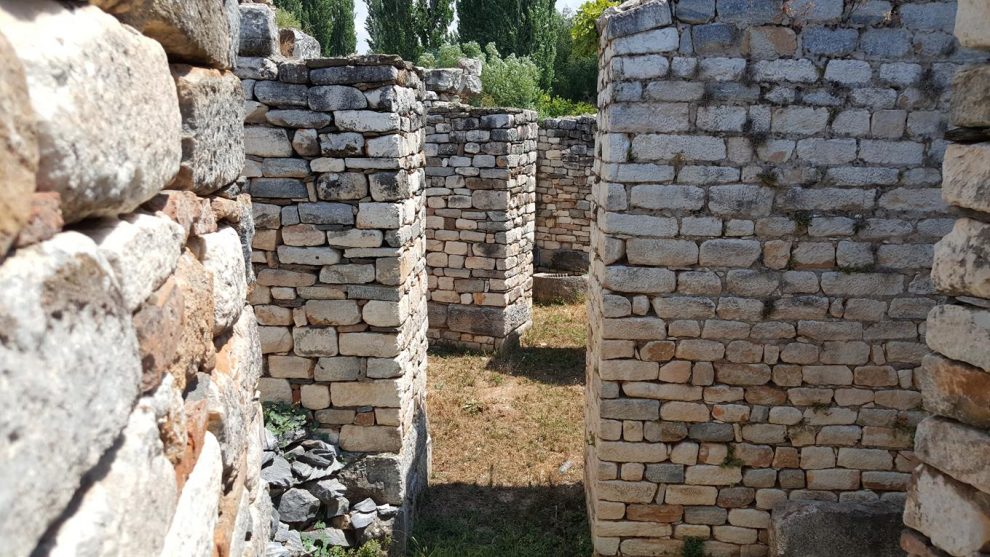
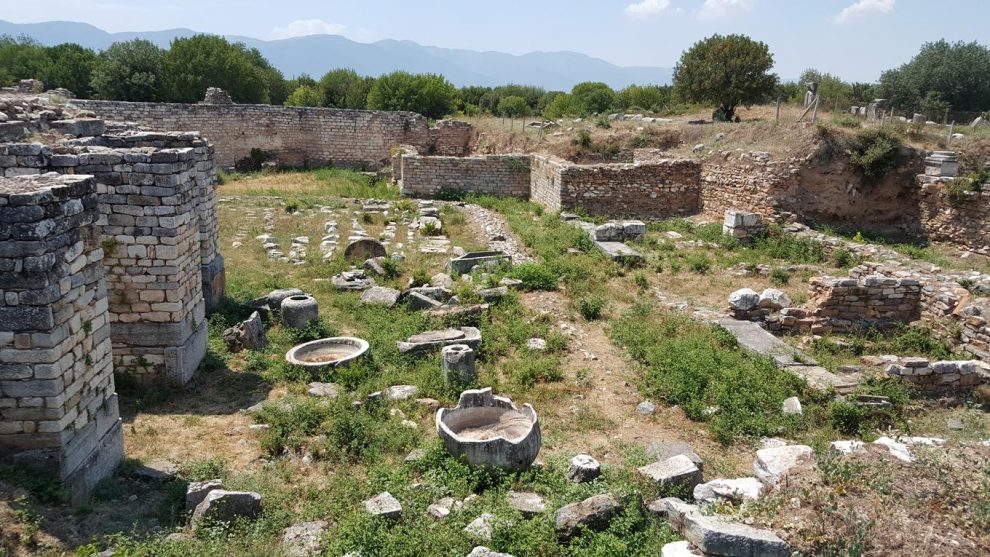
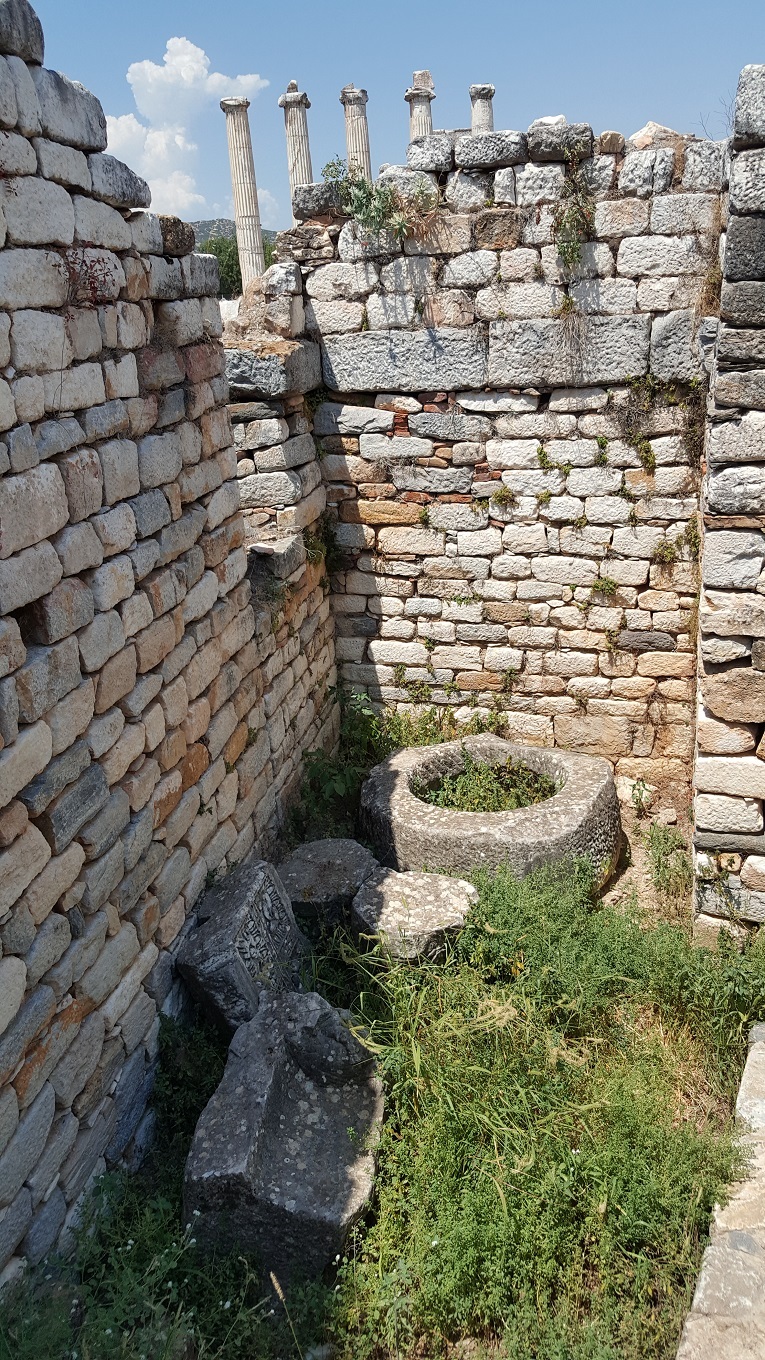
![]()
* LAHİTLER (Sarcophagi)
Aphrodisias antik kentinde kazılar esnasında bulunan lahitler.
The sarcophagi found during the excavations in the ancient city of Aphrodisias.
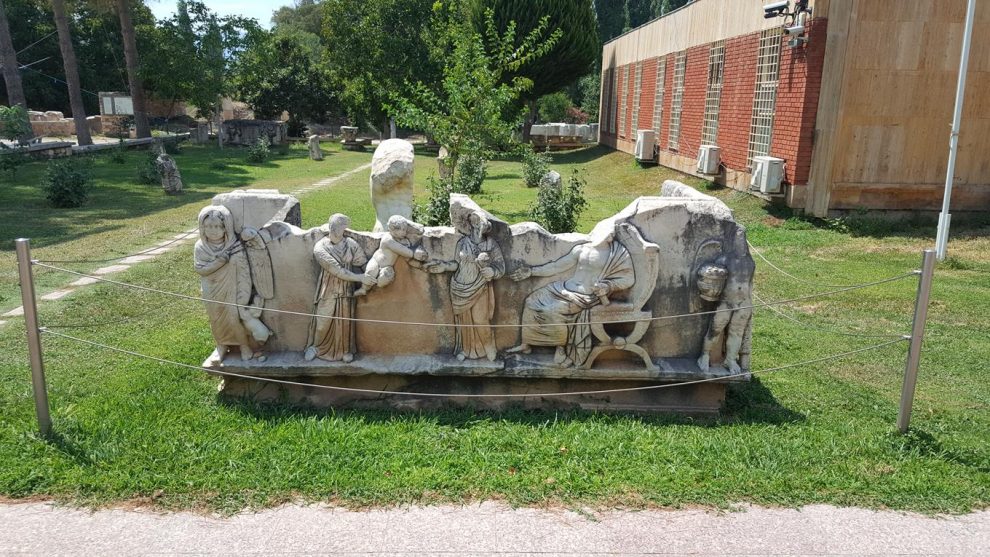
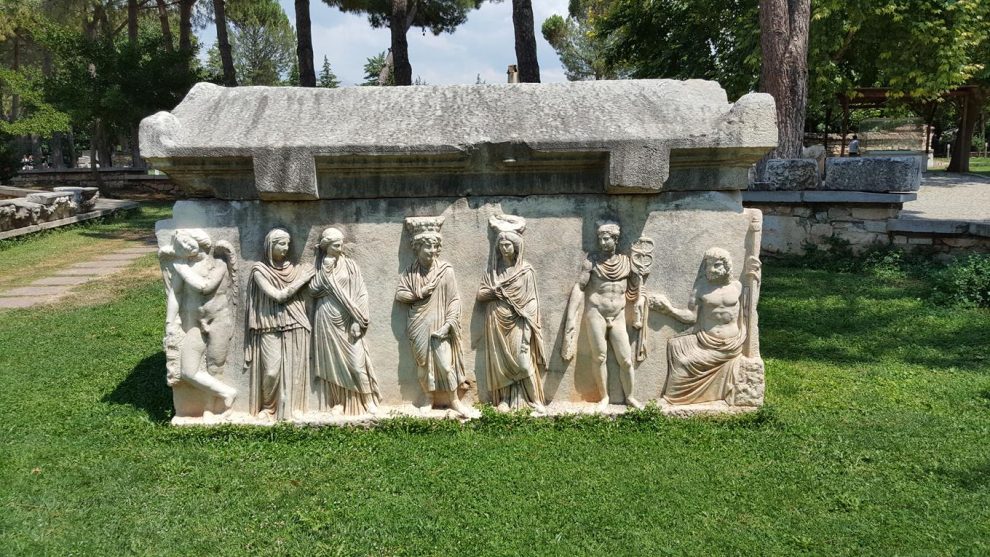
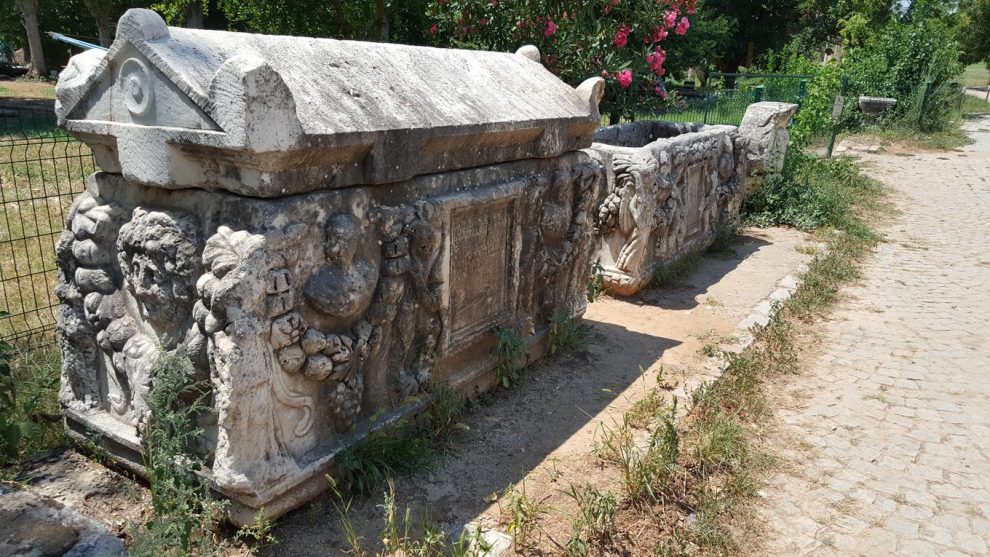
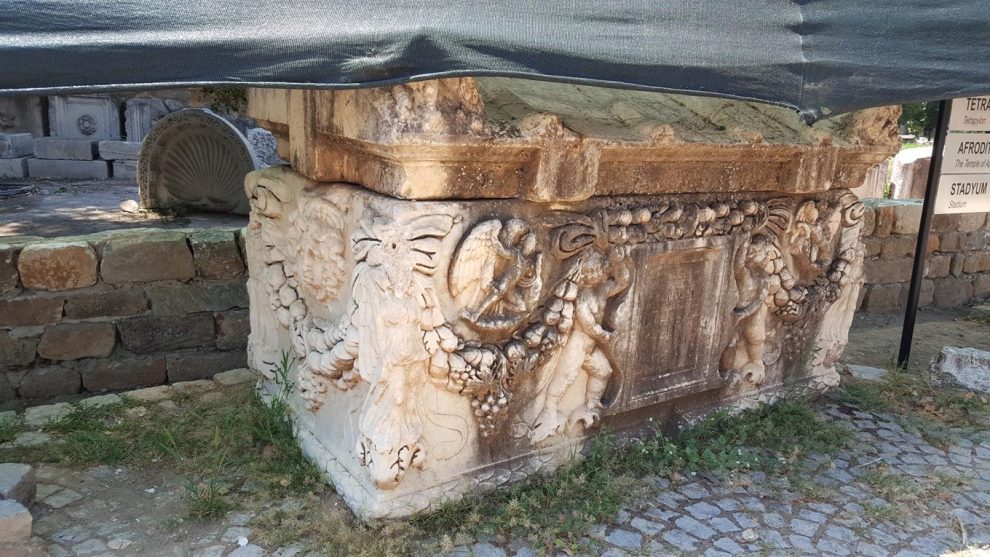
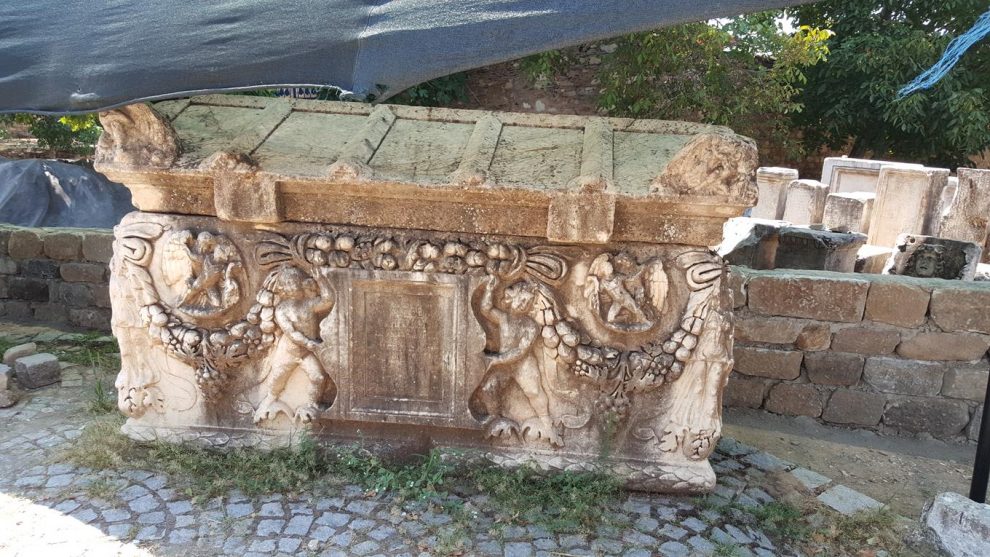
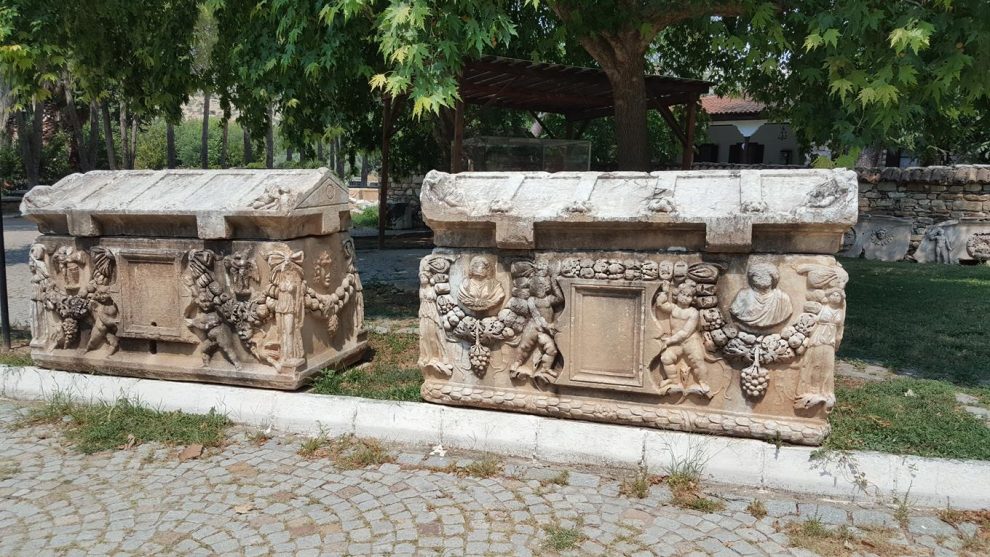
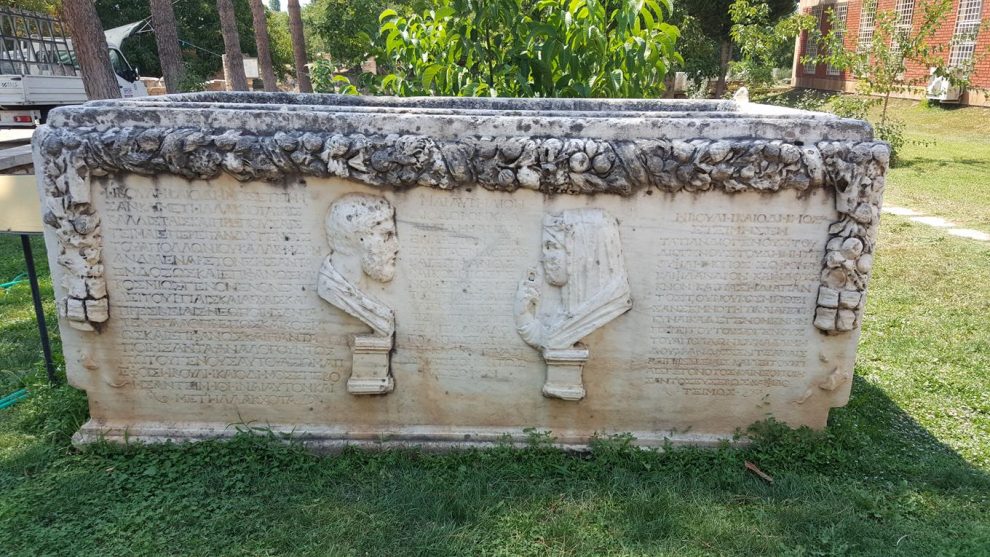
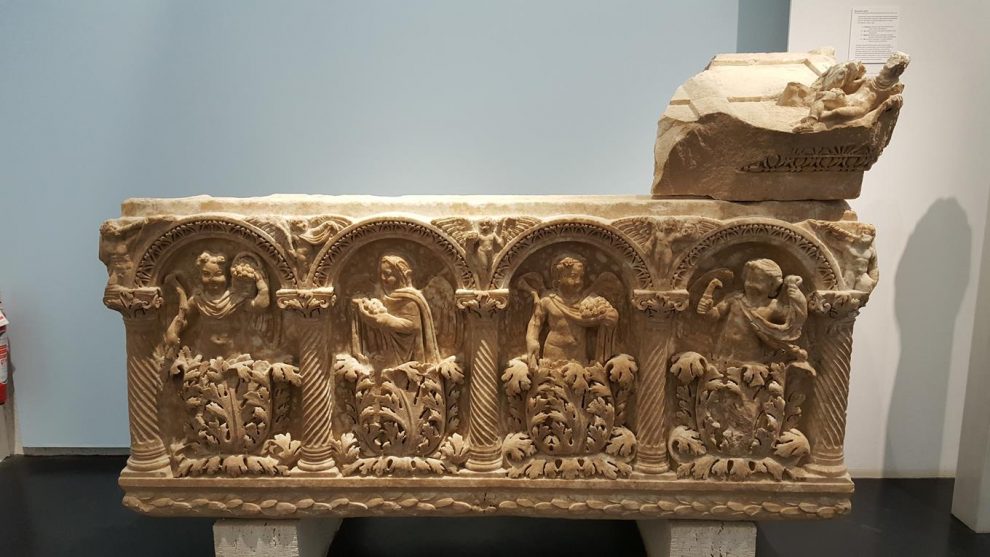
![]()
* MÜZE ve SEVGİ GÖNÜL SALONU ( Sevgi Gönül Hall and Museum)
Aphrodisias Müzesi 1979 tarihinde kazılarla bulunan eserlerin sergilenmesi için açılmıştır. Müzede bulunan eserlerin bir çoğunu heykeller oluşturmaktadır. Müze ilk yapıldığında küçüktü daha sonra Kültür Bakanlığı, Anıtlar Kurulu’nun onayı ile eskisine ek bir müze olarak sadece Sebastion yontularının sergilenmesi için Sevgi Gönül salonu açılmıştır.
Aphrodisias Müzesinde ünlü antik filozof ve devlet adamlarının tondo büstleri, imparator heykelleri, portre heykeller, portre büstler ve üzerinde mevsimleri betimleyen figürlerin bulunduğu bir lahit, kentin ikinci kurucusu Zoilos’un anıt mezarı, giyimli devlet adamları, sanatçılara ait heykeller ve tamamlanmamış bazı heykeller bulunmaktadır.
The Aphrodisias Museum was opened in 1979 to exhibit artifacts found in the excavations. Most of the works in the museum are sculptures. When the museum was first built, Sevgi Gönül Hall was opened for the exhibition of Sebastion sculptures only as an additional museum with the approval of the Ministry of Culture, Monuments Board.
The famous antique philosopher and statesmen of Aphrodisias Museum include a tombstone with tondo busts, emperor sculptures, portrait sculptures, portrait busts and figures depicting the seasons on it, the monumental tomb of Zoilos, the second founder of the city, sculpted statesmen, artists’ sculptures and some incomplete sculptures.
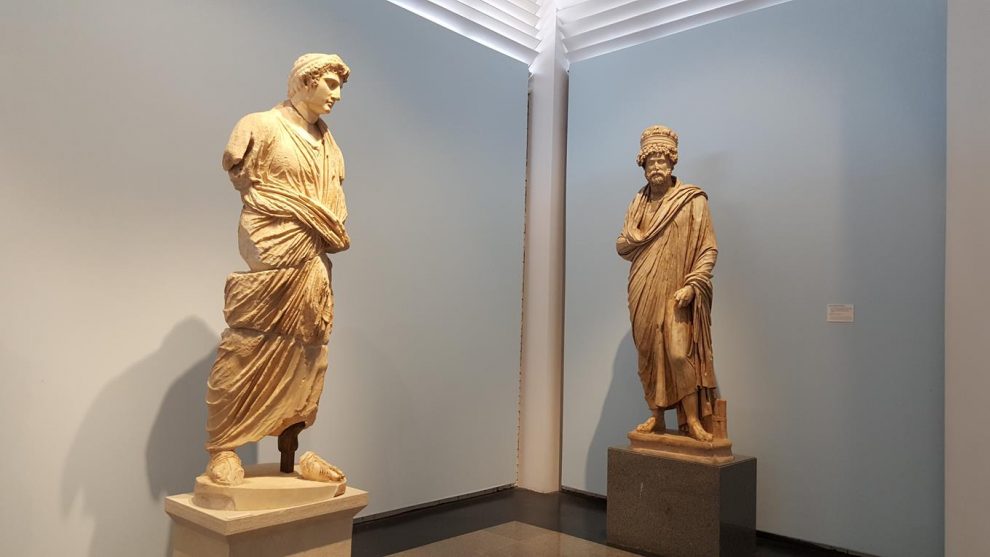
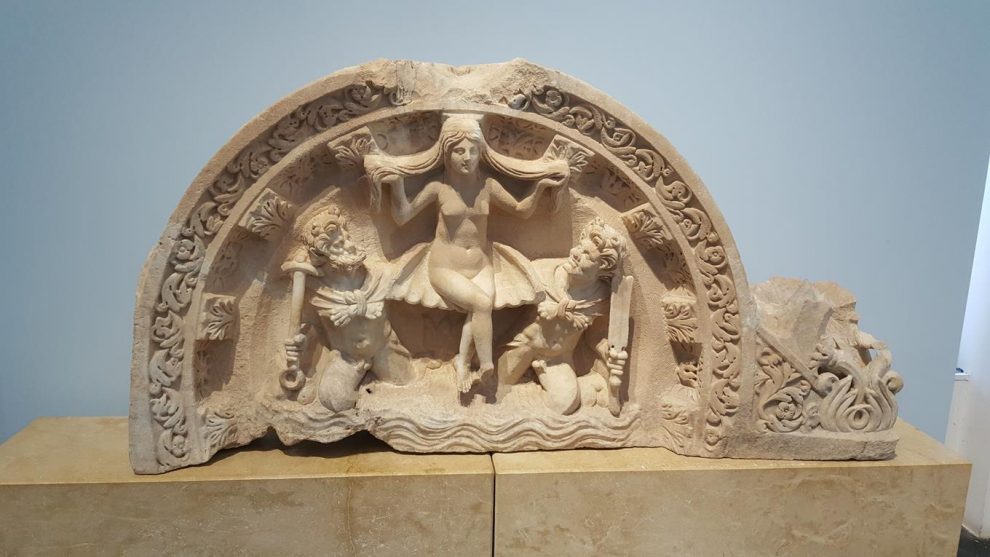
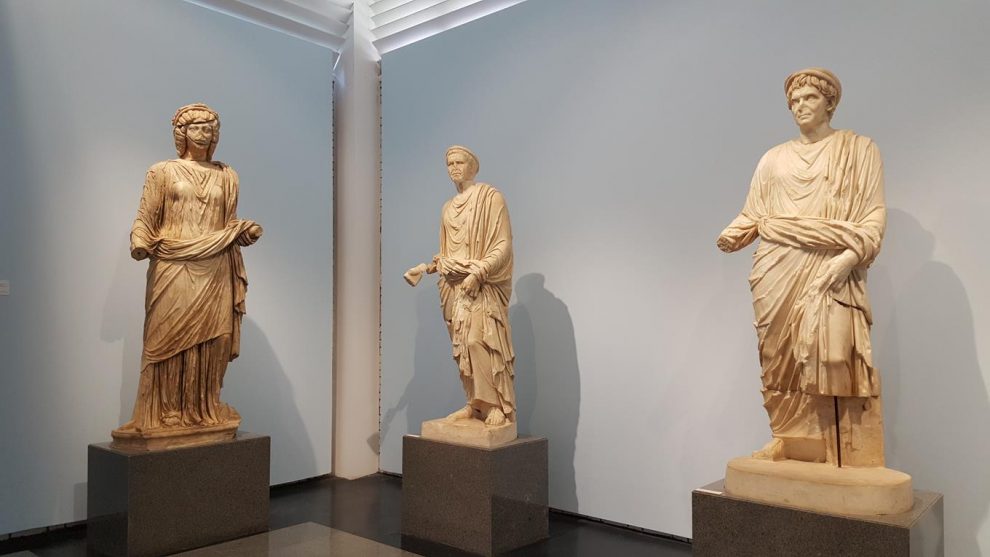
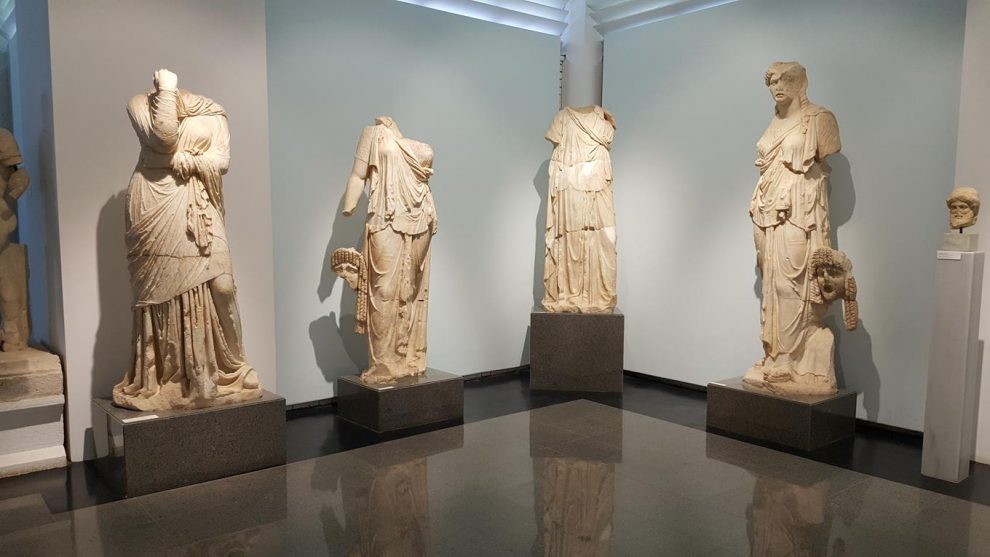
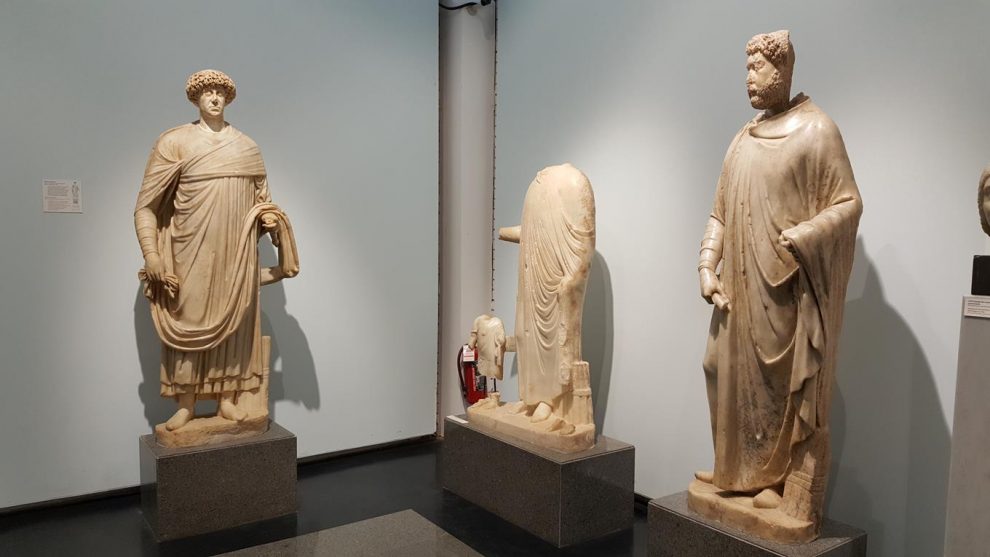
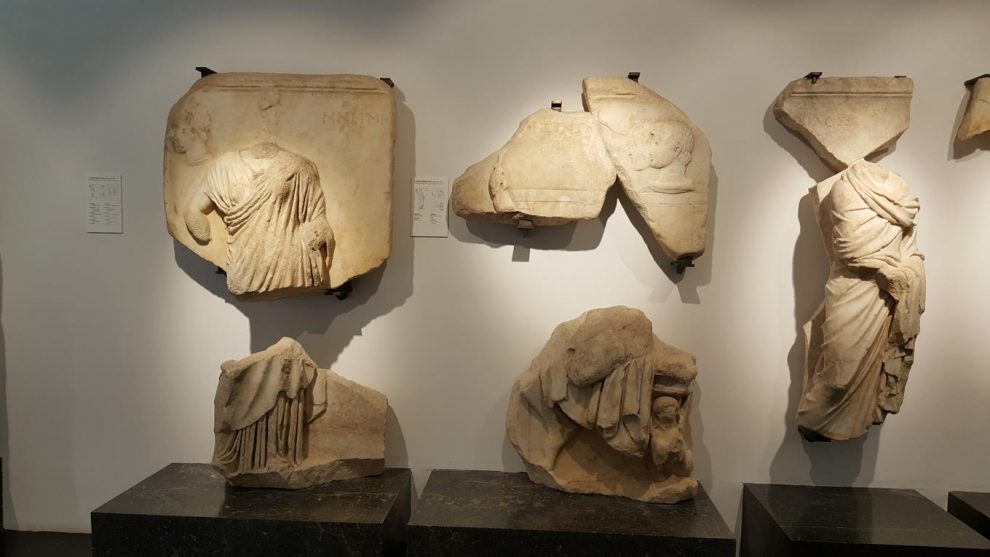
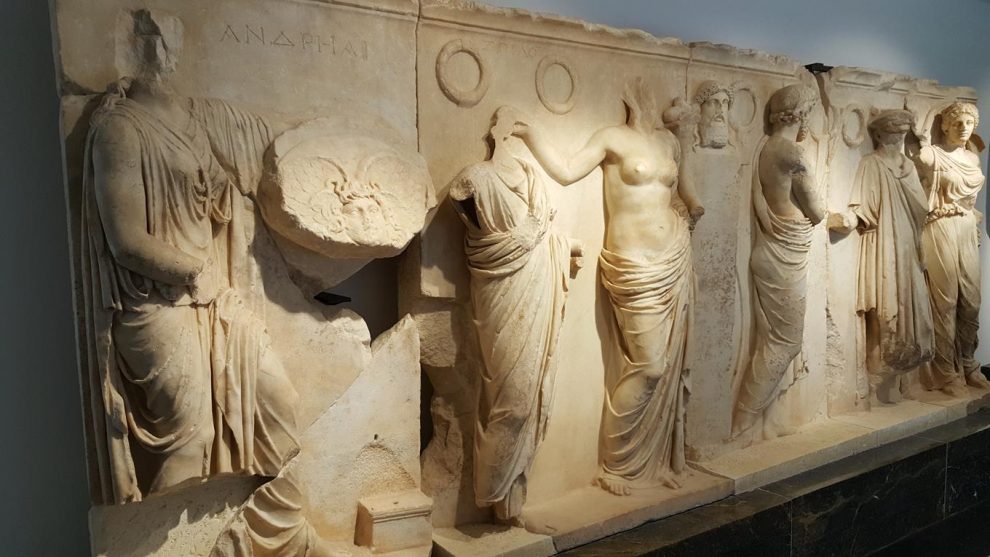
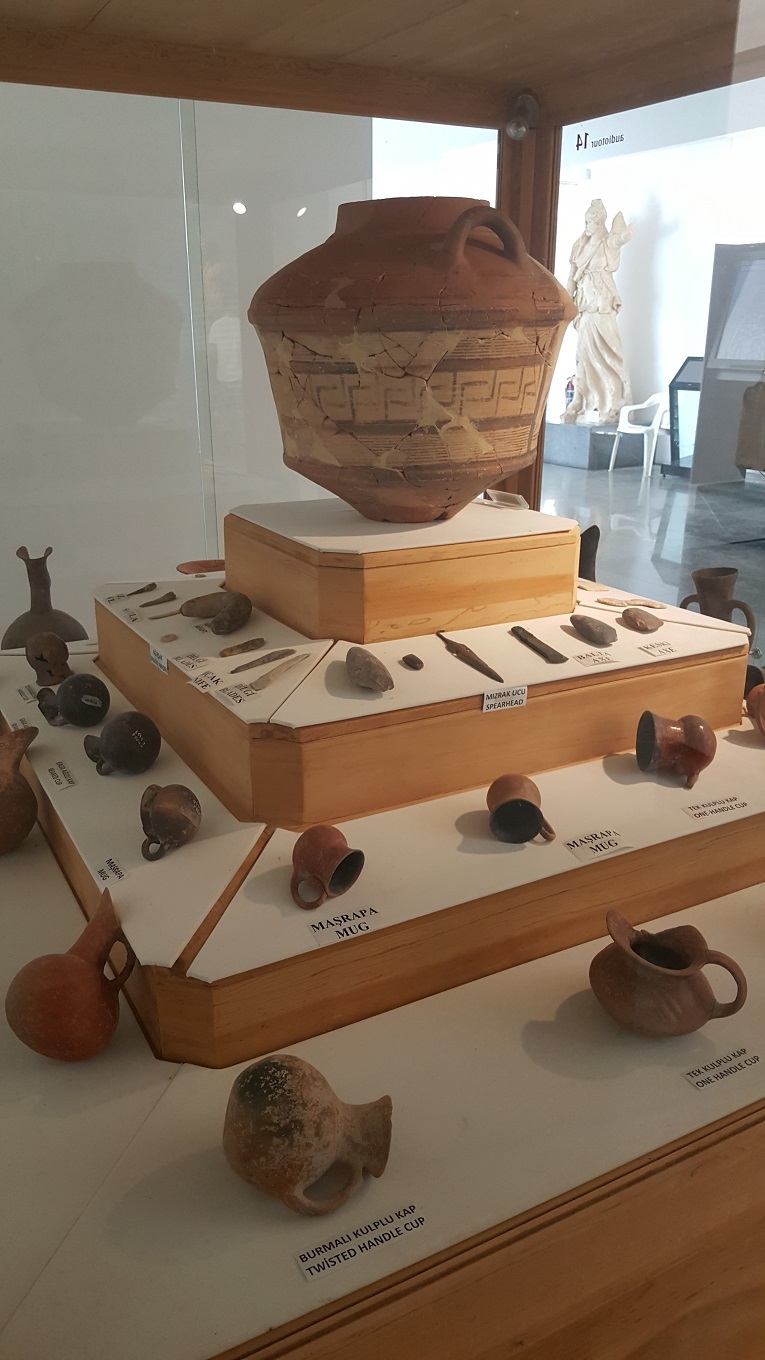
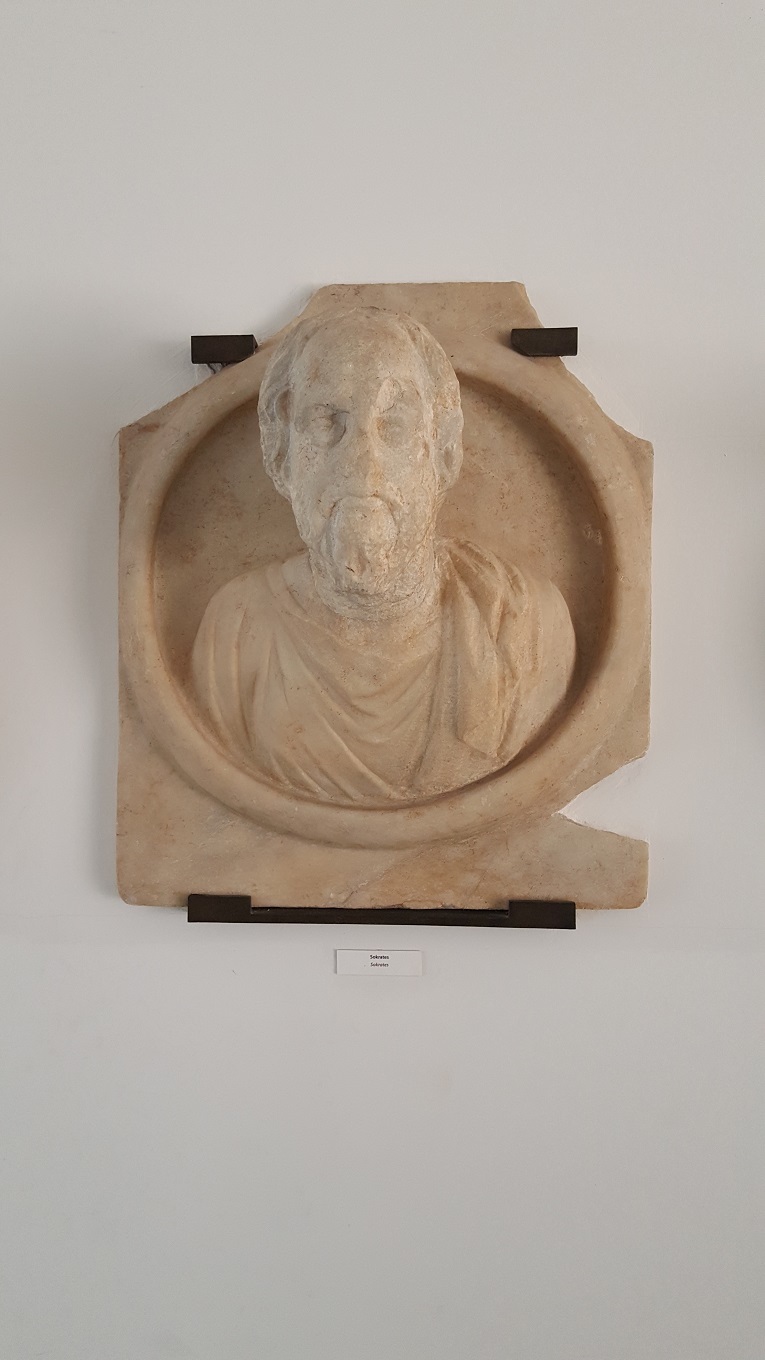
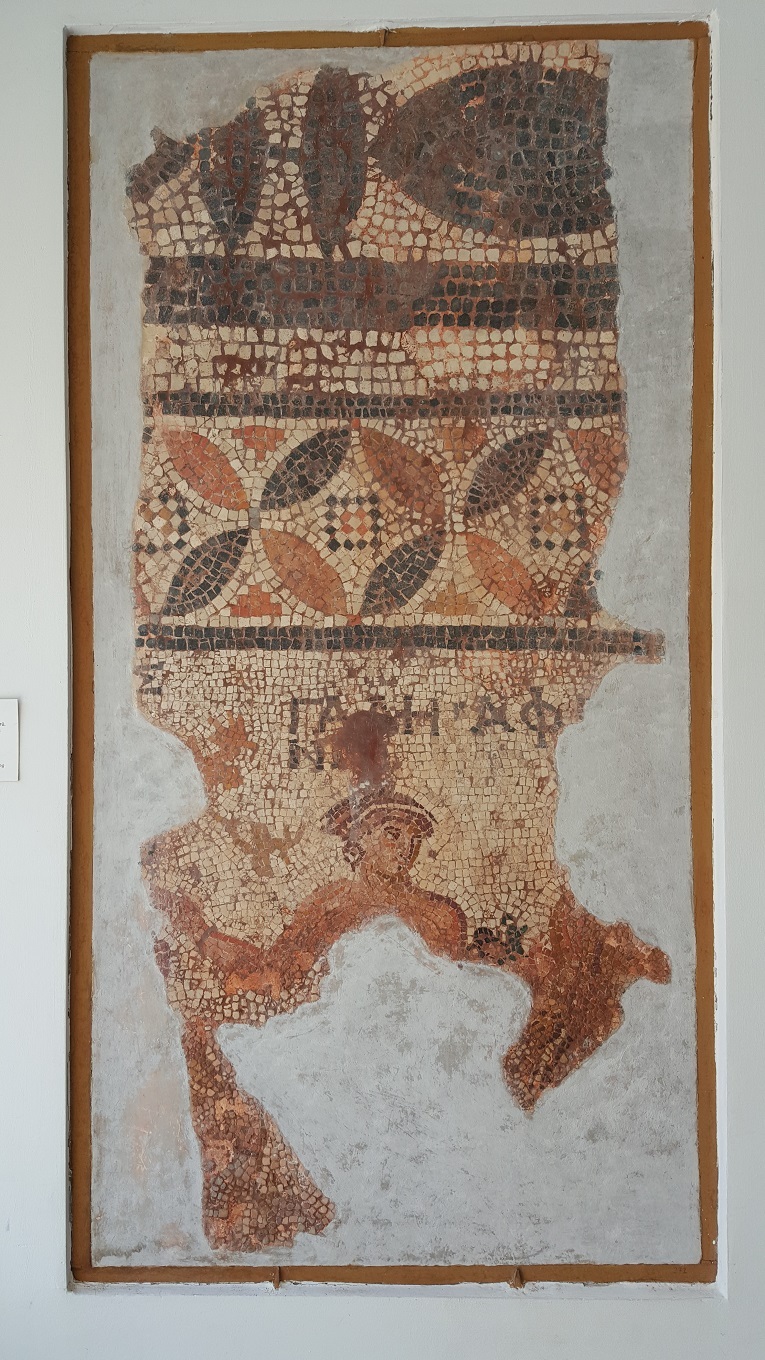
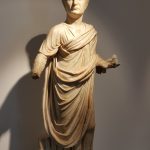 Yarı tamamlanmamış togalı memur heykeli. Elinde mürekkep hokkası vardır. Heykel Atölyesi’nde bulunmuştur. M.Ö. 400.
Yarı tamamlanmamış togalı memur heykeli. Elinde mürekkep hokkası vardır. Heykel Atölyesi’nde bulunmuştur. M.Ö. 400.
Unfinished togatus statue of office-holder, with inkpot. From Sculptor’s Workshop. c. AD 400.
Aphrodisias Afrodit‘i. Bouleuterion’da bulunmuştur. M.S. 2. Yüzyıl. Afrodit kült heykelinin en iyi korunmuş versiyonudur. Başı örtülüdür ve kalın bir üst giysi (epengytes) giymektedir. Giysinin üzerinde şu motifler bulunur: (a) Üç Güzeller, (b) Ay ve Güneş, (c) Afrodit deniz keçisine binerken, (d) Eros figürleri kurban töreninde.
Aphrodite of the City. From Bouleuterion. Second century AD. The best preserved version of the cult statue of Aphrodite in her temple. Her head was veiled and she wears a heavy casing (epengytes) on which are (a) Three Graces, (b) Moon and Sun, (c) Aphrodite on a sea-goat, and (d) Eros Figures sacrificing.
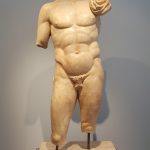 Çıplak kahraman, Akhilles. Hadrian Hamamları’nda bulunmuştur. M.S. 1.-2. yy.
Çıplak kahraman, Akhilles. Hadrian Hamamları’nda bulunmuştur. M.S. 1.-2. yy.
Naked hero, Achilles. From Hadrianic Baths. First-second century AD.
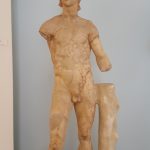 Üzüm yaprağından taç giyen Herakles. Heykel Atölyesi’nde bulunmuştur. M.S. geç 2. veya 3. yy.
Üzüm yaprağından taç giyen Herakles. Heykel Atölyesi’nde bulunmuştur. M.S. geç 2. veya 3. yy.
Herakles wearing grapevine wreath. From Sculptor’s Workshop.
Later second or third century AD.
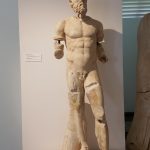 Candidianus, Boksör. Tiyatro’da bulunmuştur. M.S. geç 3. yy. Heykel antik çağda yoğun biçimde onarılmış ve yeniden kullanılmış bir kaideye yerleştirilmiştir.
Candidianus, Boksör. Tiyatro’da bulunmuştur. M.S. geç 3. yy. Heykel antik çağda yoğun biçimde onarılmış ve yeniden kullanılmış bir kaideye yerleştirilmiştir.
Candidianus, Boxer. From Theater. Late third century AD. The statue was heavily repaired in antiquity and set up on a re-used base.
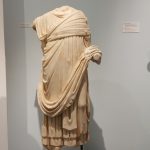 Toga giymiş vali ya da imparator. Bouleuterion’da bulunmuştur. M.S. 5. yy.
Toga giymiş vali ya da imparator. Bouleuterion’da bulunmuştur. M.S. 5. yy.
Governor or emperor wearing toga. From Bouleuterion. Fifth century AD.
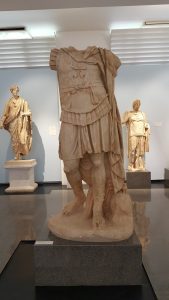
Tören zırhı giymiş general. Doğu Bouleuterion’da bulunmuştur. M.S. erken 1. yy. Kaidede duran geleneksel miğferin üstünde heykeli yapan ustanın adı yazmaktadır: Cyrysippos oğlu Apollonios Aster yaptı.
General in parade armour. From East Bouleuterion. Early first century AD. The old-fashioned helmet on the plinth carries the statue-maker’s name: Apollomios Aster, son of Chrysippos, made (it).
Rahip tacı giymiş önde gelen vatandaş. Doğu Bouleuterion’da bulunmuştur. M.S. erken 1. yy. Heykel, kent kıyafeti (khiton ve himation) giymiştir ve dinamik bir pozda ayakta durmaktadır. Temiz tıraşlı portre başı, heykele ait fakat heykelle birleşmeyen başın alçı kopyasıdır.
Leading citizen wearing priestly crown. From East Bouleuterion. Early first century AD. The figure wears civic dress (chiton an himation) and stands in a dynamic posture. The Clean shaven portrait is a cast of the head, which belongs but does not join.
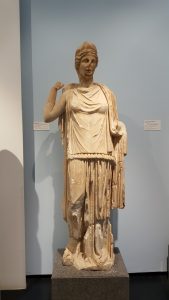
Taç giymiş tanrıça. Tiyatro’da bulunmuştur. M.S. 1. yy. Heykel, geleneksel bir elbise (peplos) giymiştir ve baş örtüsünü düzeltmektedir.
Goddess wearing crown. From Theater. First century AD. She wears an old-fashioned dress (peplos) and is arranging her veil.
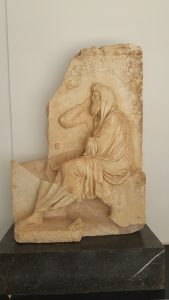
C.Julius Zoilos Anıtı. M.Ö. yaklaşık 30. Aion (sonsuzluk) uğursuzlukları ve geleceği bildiren bir kahin gibi sağ elini başına götürmektedir.
The Monument of C.Julius Zoilos (c.30 BC). AION (Eternity) He raises his right hand to his head in a gesture of foreboading and future knowledge, like a seer.
Zafer tanrıçası nike. Tiyatro’da bulunmuştur. M.Ö. 1. yy. Antik Çağ’da tiyatroda sahneyi süsleyen heykellerden biri olan bu eser kanatlı tanrıça, sağ elinde tuttuğu üst kısmı zırh süslemeli bir zafer direği ile birlikte gökyüzünden aşağı doğru inmektedir. Afrodisias’da üretilen en erken mermer yontulardan biridir.
Nike (Goddess of Victory). Scene building of Theater. Late 1st century BC. The statue decorated the stage-building of tehater. It represent Nike (Victory) landing on the building, holding a trophy. This is one of the earliest marble statues made at Aphrodisias.
![]()
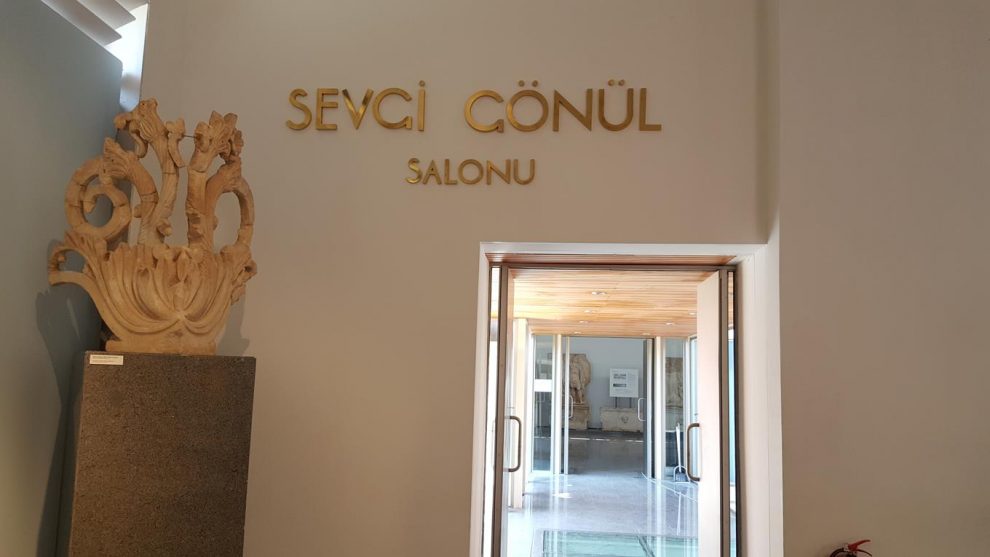
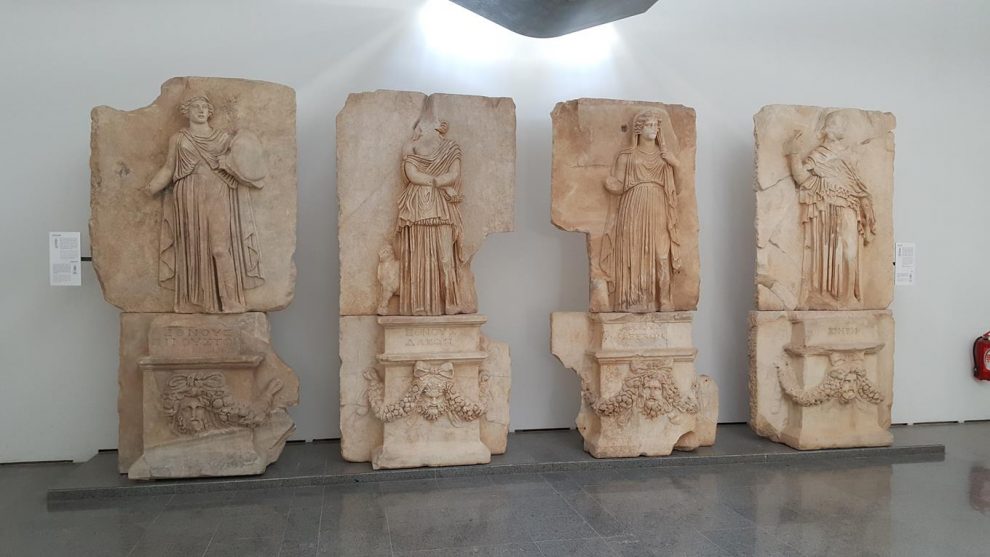
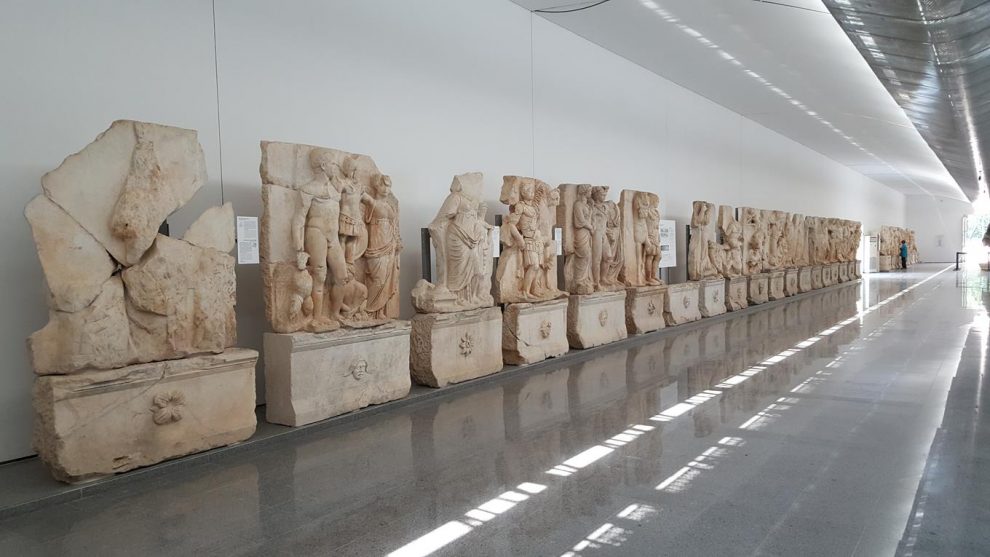
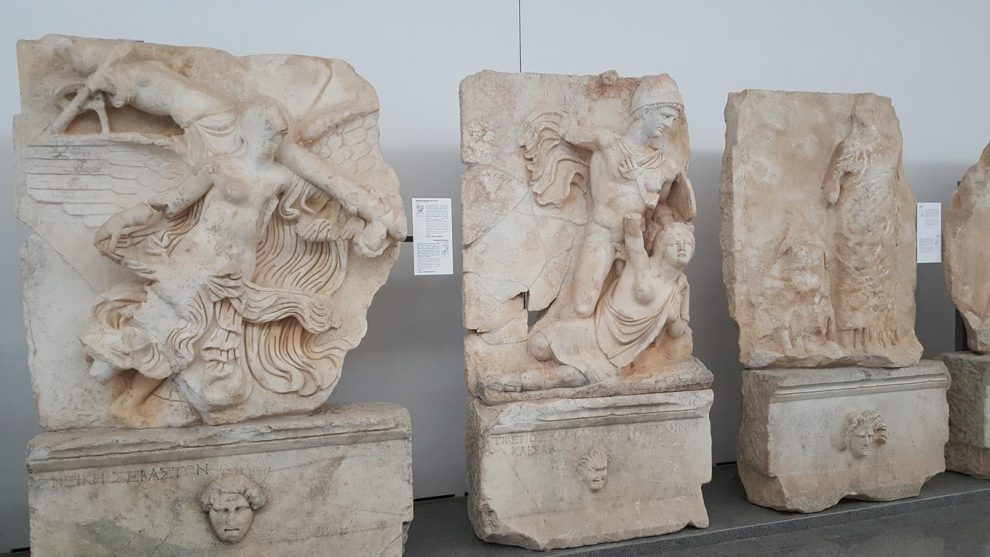
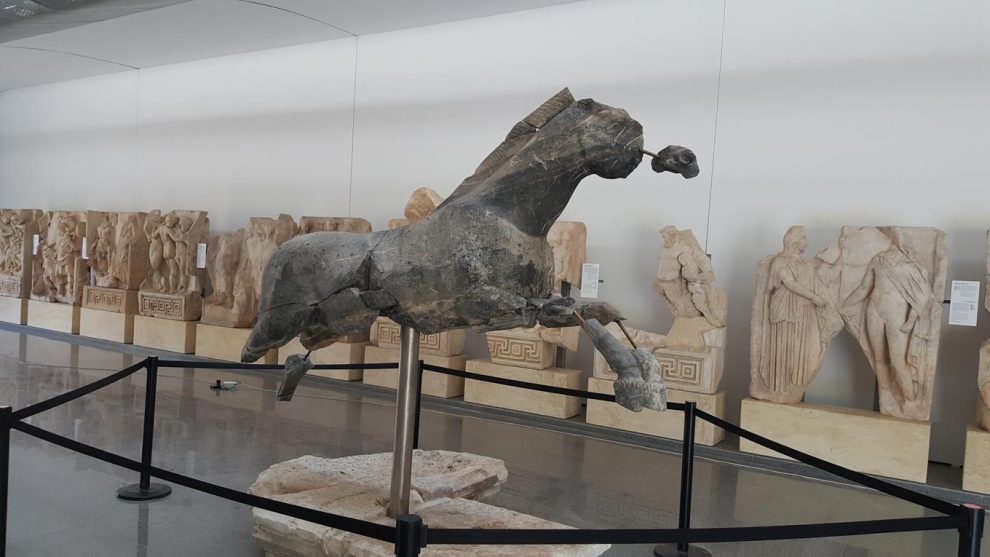
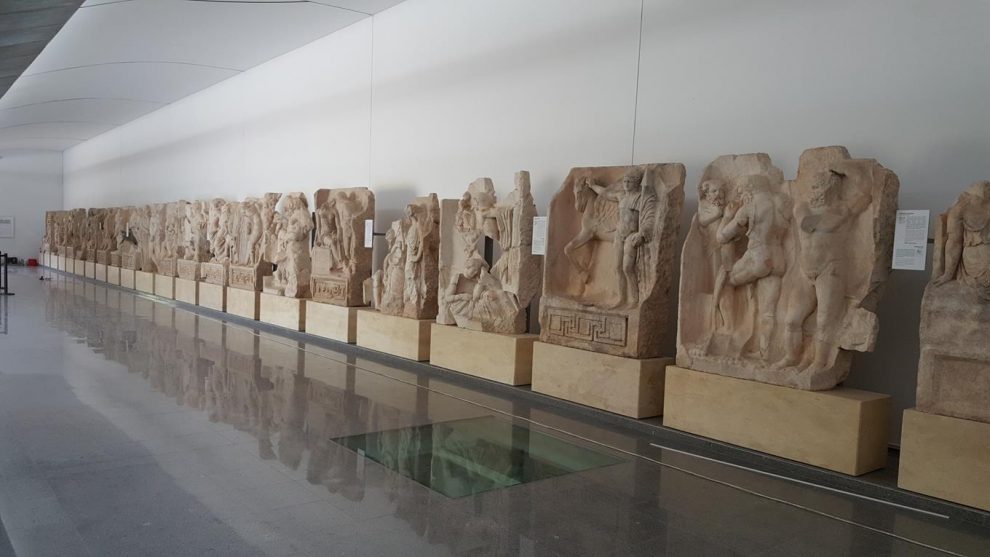
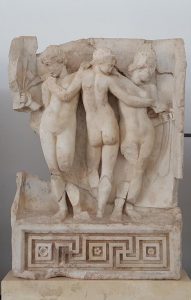 Üç Güzeller, alışılmış Helenistik kompozisyonla betimlenmişlerdir. Üç Güzeller, Aphrodite’nin hizmetkarlarıdır ve tanrıçanın Aphrodisias’daki kült heykelinin bezemesinde buradaki duruşlarıyla yer alırlar. İsimleri, karakterlerini açığa vurmaktadır: Euphrosyne (Neşe), Aglaia (Görkem) ve Thaleia (Tazelik).
Üç Güzeller, alışılmış Helenistik kompozisyonla betimlenmişlerdir. Üç Güzeller, Aphrodite’nin hizmetkarlarıdır ve tanrıçanın Aphrodisias’daki kült heykelinin bezemesinde buradaki duruşlarıyla yer alırlar. İsimleri, karakterlerini açığa vurmaktadır: Euphrosyne (Neşe), Aglaia (Görkem) ve Thaleia (Tazelik).
The Three Graces stand in their familiar hellenistic composition. They were handmaids of Aphrodite and appeared in this form on the decoration of her cult statue at Aphrodisias. Their names evoked their charater: Euphrosyne (Joy), Aglaia (Splendour) , and Thaleia (Bloom).
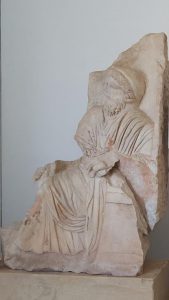 Oturan Tanrı veya Kral. Bir tanrı veya mitolojik kralı temsil eden yaşlı ve sakallı figür, tahtında oturmaktadır. Figür, elinde bir asa tutmakta, krallara özgü bir diadem ile detaylı betimlenmiş tunik ve manto giymektedir.
Oturan Tanrı veya Kral. Bir tanrı veya mitolojik kralı temsil eden yaşlı ve sakallı figür, tahtında oturmaktadır. Figür, elinde bir asa tutmakta, krallara özgü bir diadem ile detaylı betimlenmiş tunik ve manto giymektedir.
Seated God or King. An older bearded god or mythological king sits in a throne. He held a scepter and wears a royal diadem and a richly-carved tunic and cloak.
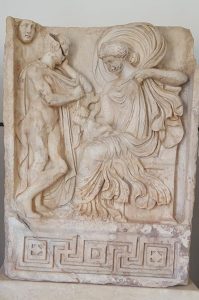 Ankhises ve Aphrodite. Troialı çoban Ankhises, bakışlarını İda Dağ’ında bir gecelik aşk yaşadığı Aphrodite’ye çevirmiştir. Oturan Aphrodite’nin, kucağında küçük Eros’u tutması erotik bir buluşmayı ifade eder. Gecenin işareti olan Selene’nin (Ay) başı yukarıda dağların üstünde görünmektedir.
Ankhises ve Aphrodite. Troialı çoban Ankhises, bakışlarını İda Dağ’ında bir gecelik aşk yaşadığı Aphrodite’ye çevirmiştir. Oturan Aphrodite’nin, kucağında küçük Eros’u tutması erotik bir buluşmayı ifade eder. Gecenin işareti olan Selene’nin (Ay) başı yukarıda dağların üstünde görünmektedir.
Anchises and Aphrodite. The Trojan shepherd Anchises gazes at the seated Aphrodite, hiz lover for one night on Mount Ida. She holds a small Eros on her lap: this is an erotic encounter. The head of Selene (Moon) appears above the mountain rocks: she indicates night-time.
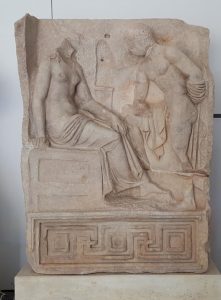 İo ve Argos. Kılıç tutan güçlü bir kahraman, sandık gibi bir tabureye oturan yarı çıplak ve darmadağın genç kadına gözlerini dikmiş bakmaktadır. İkisinin arasında, sütundan bir kaide üzerinde küçük bir tanrıça heykeli durmaktadır (günümüze ulaşmamıştır). Sahne, en çok İo’nun Argos tarafından gözetlenmesi hikayesi için kullanılan kalıba uygundur. İo, Zeus’un sevgililerinden biridir ve Argos, Zeus’un eşi Hera tarafından İo’yu gözetlemekle görevlendirilmiş bir devdir.
İo ve Argos. Kılıç tutan güçlü bir kahraman, sandık gibi bir tabureye oturan yarı çıplak ve darmadağın genç kadına gözlerini dikmiş bakmaktadır. İkisinin arasında, sütundan bir kaide üzerinde küçük bir tanrıça heykeli durmaktadır (günümüze ulaşmamıştır). Sahne, en çok İo’nun Argos tarafından gözetlenmesi hikayesi için kullanılan kalıba uygundur. İo, Zeus’un sevgililerinden biridir ve Argos, Zeus’un eşi Hera tarafından İo’yu gözetlemekle görevlendirilmiş bir devdir.
Io and Argos. A powerful hero holding a sword gazes closely at a half-naked and dishevelled young heroine who sits on a chest-like stool. Between, on a pillar-base stood a small, separately added statue of a scheme used for (among others) Io guarded by Argos. Io was one of Zeus’s lovers, and Argos was awatchful giant sent to guard her by Hera, Zeus’s wife.
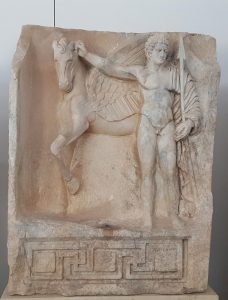 Bellerophontes. Bellerophontes, Aphrodisias’ın kurucusu olduğuna inanılan Likyalı kahramandır. Kahraman, atı Pegasus’u tutmaktadır. Sahne, bu dizideki bir başka kabartma panel ( Soylu kahraman ve av köpekleri) model alınarak tasarlanmıştır. Heykeltraşlık başarılı değildir; belli ki heykeltraş henüz sanatını öğrenme aşamasındadır.
Bellerophontes. Bellerophontes, Aphrodisias’ın kurucusu olduğuna inanılan Likyalı kahramandır. Kahraman, atı Pegasus’u tutmaktadır. Sahne, bu dizideki bir başka kabartma panel ( Soylu kahraman ve av köpekleri) model alınarak tasarlanmıştır. Heykeltraşlık başarılı değildir; belli ki heykeltraş henüz sanatını öğrenme aşamasındadır.
Bellerophon. Bellerophon was a Lykian hero, and was claimed as a founder at Aphrodisias. He holds his winged horse Pegasos. The design was modeled on an-other relief panel in this series (Royal hero with hunting dgos). The carving is poor: the sculptor seems still to have been learnin g his craft.
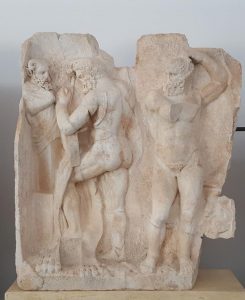 Herakles ve Antaios. Herakles, Libyalı dev Antaios ile güreşe hazırlanmaktadır. Herakles (solda), yay kılıfını çıkarmış, kırda duran ve payeye benzeyen heykele asmaktadır. Antaios (sağda), kulaklarını korumak amacıyla başını sarmaktadır; yanında ise güreş sahasında kullanılan yağ tenekesi durmaktadır. Ünlü bir güreşçi olan Antaios, Herakles tarafından yenilinceye kadar, ülkesine gelen ziyaretçilere kafa tutmuş ve hepsi öldürmüştür.
Herakles ve Antaios. Herakles, Libyalı dev Antaios ile güreşe hazırlanmaktadır. Herakles (solda), yay kılıfını çıkarmış, kırda duran ve payeye benzeyen heykele asmaktadır. Antaios (sağda), kulaklarını korumak amacıyla başını sarmaktadır; yanında ise güreş sahasında kullanılan yağ tenekesi durmaktadır. Ünlü bir güreşçi olan Antaios, Herakles tarafından yenilinceye kadar, ülkesine gelen ziyaretçilere kafa tutmuş ve hepsi öldürmüştür.
Herakles and Antaios. Herakles is preparing to wrestle the Libyan giant Antaios. Herakles (left) is taking off his bow-case to hang it on a rustic pillar-statue. Antaios (right) is binding up his head with ear-protectors; nest to him stands an oil basin as used in the palaistra (wrestling ground). Antaios was a famous wrestler and challenged and killed all visitors to his country, until de-feated by Herakles.
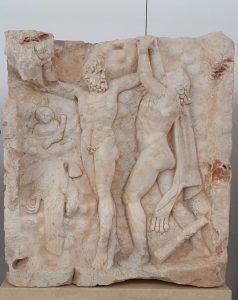 Herakles tarafından kurtarılan Prometheus. Prometheus acı içinde haykırmaktadır. Zeus, onu insanlara ateşi verdiği için korkunç bir cezaya çarptırmıştır: Hergün gelen bir kartal, Kafkas Dağları’na bağlanmış olan Prometheus’un ciğerini yemektedir. Herakles kartalı öldürmüş, kahramanı bağlayan ilk kelepçeyi açmaktadır. Herakles’in kendine özgü alan postu omzunda, topuzu da yanındadır. Küçük bir dağ perisi (nymphe), elinde ucu kıvrık avcı değneği ile yukarıdaki kayalıkta belirmiştir.
Herakles tarafından kurtarılan Prometheus. Prometheus acı içinde haykırmaktadır. Zeus, onu insanlara ateşi verdiği için korkunç bir cezaya çarptırmıştır: Hergün gelen bir kartal, Kafkas Dağları’na bağlanmış olan Prometheus’un ciğerini yemektedir. Herakles kartalı öldürmüş, kahramanı bağlayan ilk kelepçeyi açmaktadır. Herakles’in kendine özgü alan postu omzunda, topuzu da yanındadır. Küçük bir dağ perisi (nymphe), elinde ucu kıvrık avcı değneği ile yukarıdaki kayalıkta belirmiştir.
Prometheus Freed by Herakles. Prometheus is screaming in pain. Zeus had given him a terrible punishment for giving fire to man: he was tied to the Caucasus mountains and had his liver pecked out daily by an eagle. Herakles has shot the eagle and is undoing the first mannacle. He wears his trade-mark lion-skin and has thrown his club aside. A small montain nymph, holding a throwing stick, ap- pears among the rocks above.
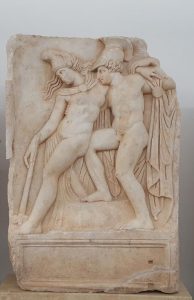 Akhilleus vs Penthesilea. Akhilleus, ölümcül derecede yaralığı yere düşen Amazon kraliçesi Penthesilea’yı kaldırmaktadır. Penthesilea’nın çift ağızlı baltası elinden kaymaktadır. Kraliçe, Troia Savaşı’nda işgalci Yunanlılara karşı savaşmaya gelmiştir. Akhilleus, burada betimlenen zaman aralığında, yani kraliçenin yaralandığı ve Akhilleus’un kollarında can verdiği süre içinde, kraliçeye aşık olmuştur.
Akhilleus vs Penthesilea. Akhilleus, ölümcül derecede yaralığı yere düşen Amazon kraliçesi Penthesilea’yı kaldırmaktadır. Penthesilea’nın çift ağızlı baltası elinden kaymaktadır. Kraliçe, Troia Savaşı’nda işgalci Yunanlılara karşı savaşmaya gelmiştir. Akhilleus, burada betimlenen zaman aralığında, yani kraliçenin yaralandığı ve Akhilleus’un kollarında can verdiği süre içinde, kraliçeye aşık olmuştur.
Achilles and Penthesilea. Achilles supports the slumping figure of the Amazon queen Penthesilea, whom he has mortally wounded. Her double-headed axe slips from her hand. The queen had come to fight in the Trojan War against the invading Greeks. Between her being wounded and dying in his arms – the time represented here – Achilles fell in love with her.
![]()
veee…
* Prof. Dr. KENAN TEVFİK ERİM (Arkeolog)
Afrodisias antik kenti ortaya çıkaran arkeolog olarak bilinen Kenan Tevfik Erim, 1929 Şubat ayında İstanbul’da doğmuştur. Babası diplomat olan Kenan Erim eğitimine İsviçre’de başladı daha sonra 1948 yılından itibaren eğitimine New York Üniversitesi’nde devam etmiştir. 1953 yılında New York Üniversitesi Klasik Arkeoloji bilim dalında mezun oldu. Yüksek lisans ve doktorasını Princeton Üniversitesi’nde tamamlamıştır.
 Kenan Erim 1961 yılında kişiesel girişimleriyle keşif ve kazı programı ile Afrodisias’ta çalışmalarına başlamıştır. Afrodisias kazılarının maliyetinin yüksek olması nedeniyle ABD kaynaklı finansmanların temin edilmesinde büyük katkı sağlamıştır. New York başta olmak üzere İzmir, İstanbul (Geyre Vakfı), Paris ve Londra da Aphrodisias Sevenler Derneklerini kurdurmuştur.
Kenan Erim 1961 yılında kişiesel girişimleriyle keşif ve kazı programı ile Afrodisias’ta çalışmalarına başlamıştır. Afrodisias kazılarının maliyetinin yüksek olması nedeniyle ABD kaynaklı finansmanların temin edilmesinde büyük katkı sağlamıştır. New York başta olmak üzere İzmir, İstanbul (Geyre Vakfı), Paris ve Londra da Aphrodisias Sevenler Derneklerini kurdurmuştur.
Kenan Erim Aphrodisias’a ilk geldiğinde gözlenimlerini şu şekilde aktarmaktadır: “1959 yılının Temmuzunda Nazilli’den yola çıktığımda bu denli önemli bir seyahat olduğunu tahmin bile edemezdim. Karacasu’dan sonra çok kötü toprak bir yolla Geyre’ye ulaşmadan önce Aphrodithe Tapınağının sütunlarını gördüm. Köy tamamen Aphrodisias’ı kaplamıştı. Ancak muhteşemliğini gizleyememişti. Akşam olmadan Jeepim beni tekrar Nazilli’ye ulaştırdı. İlçenin tek otelindeki odamda günlüğüme şunları yazdığımı hatırlıyorum. Hayatımda yeni bir dönem başlıyor.” (Alıntı)
Ömrünün yarısını (30 yıl) bu kentin ortaya çıkarılmasına harcayan Arkeolog Prof. Dr. Kenan Erim, 3 Kasım 1990 yılında Ankara’da hayatını kaybetmiştir. Mezarı Aphrodisias Antik kentinde bulunan Anıtsal Tören Kapısı’nın (Tetrapylon) güney tarafında yer almaktadır.
Kitapları:
– Aphrodisias and Rome: Documents from the Excavation of the Theatre at Aphrodisias Conducted by Professor Kenan T. Erim, Together with Some Related Texts – 1981
– Aphrodisias, city of Venus Aphrodite – 1986
– Aphrodisias, guide du site et de son Musée – 1989
– Aphrodisias: ein Führer durch die antike Stadt und das Museum – 1990
Ödülleri: Guggenheim ABD & Kanada Beşerî Bilimler Bursu
and …
* Prof. Dr. KENAN TEVFİK ERİM (Archaeologist)
Kenan Tevfik Erim, known as the archeologist who discovered the ancient city of Aphrodisias, was born in Istanbul in February 1929.His father, diplomat Kenan Erim started his education in Switzerland and then continued his education at New York University since 1948. In 1953, he graduated from the Department of Classical Archeology at the University of New York. He completed his master’s and doctorate at Princeton University.
Kenan Erim started to work in Aphrodisias in 1961 with the initiative of exploration and excavation with the initiative of personli. Because of the high cost of Aphrodisias excavations, it has made a major contribution to the procurement of US funding. He founded Aphrodisias Sevenler Associations in New York, Izmir, Istanbul (Geyre Foundation), Paris and London.
When Kenan Erim arrives in Aphrodisias for the first time, he conveys his observations as follows: “I could not even imagine that this journey was such a significant journey from Nazilli in July 1959. After Karacasu I saw the pillars of the Temple of Aphrodite before reaching Geyre by a very bad earth way. The village was completely covered with Aphrodisias. But he could not hide his greatness. Without dinner, my Jeepim brought me back to Nazilli. I remember I wrote the diary in my room at the county’s only hotel. A new era is beginning in my life. ”
The archaeologist Professor who spent the half of his life (30 years) in uncovering this city. Dr. Kenan Erim lost his life in Ankara on 3 November 1990. The grave is located on the southern side of the Monumental Ceremonial Gate (Tetrapylon) in the ancient city of Aphrodisias.
Books:
– Aphrodisias and Rome: Documents from the Excavation of the Aphrodisias Conducted by Professor Kenan T. Erim, Together with Some Related Texts – 1981
– Aphrodisias, city of Venus Aphrodite – 1986
– Aphrodisias, guide du site et de Musée – 1989
– Aphrodisias: ein Führer durch die antike Stadt und das Museum – 1990Awards: Guggenheim USA & Canada Scholarship for Humanities
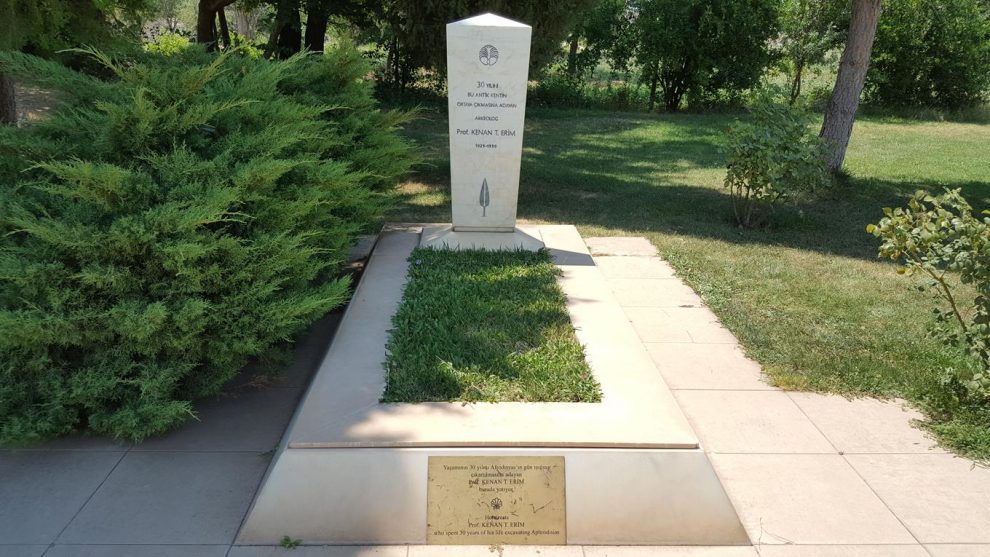
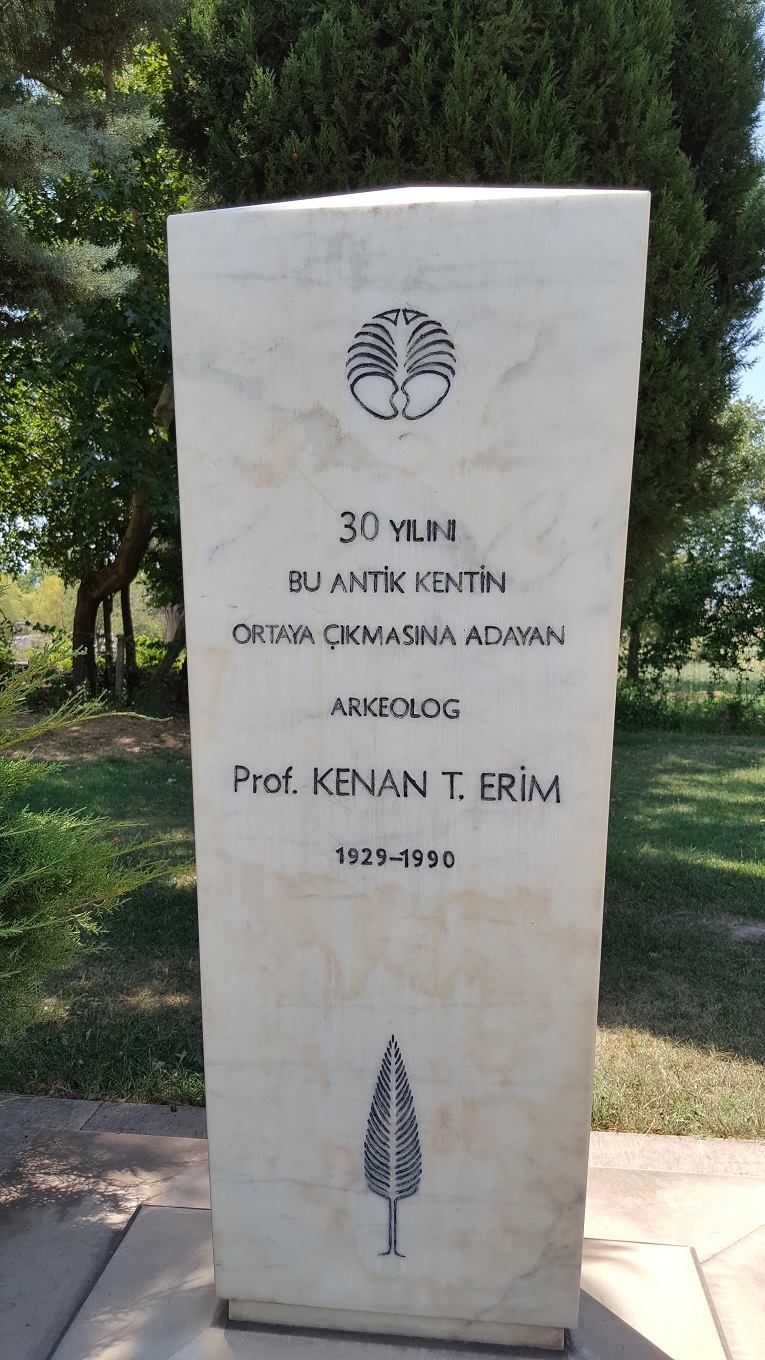
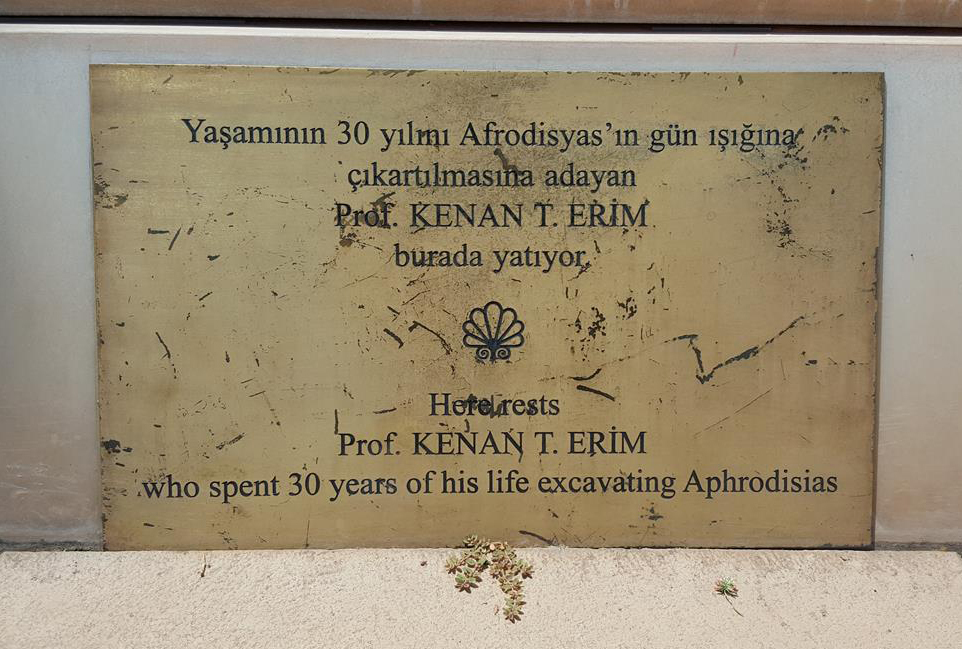
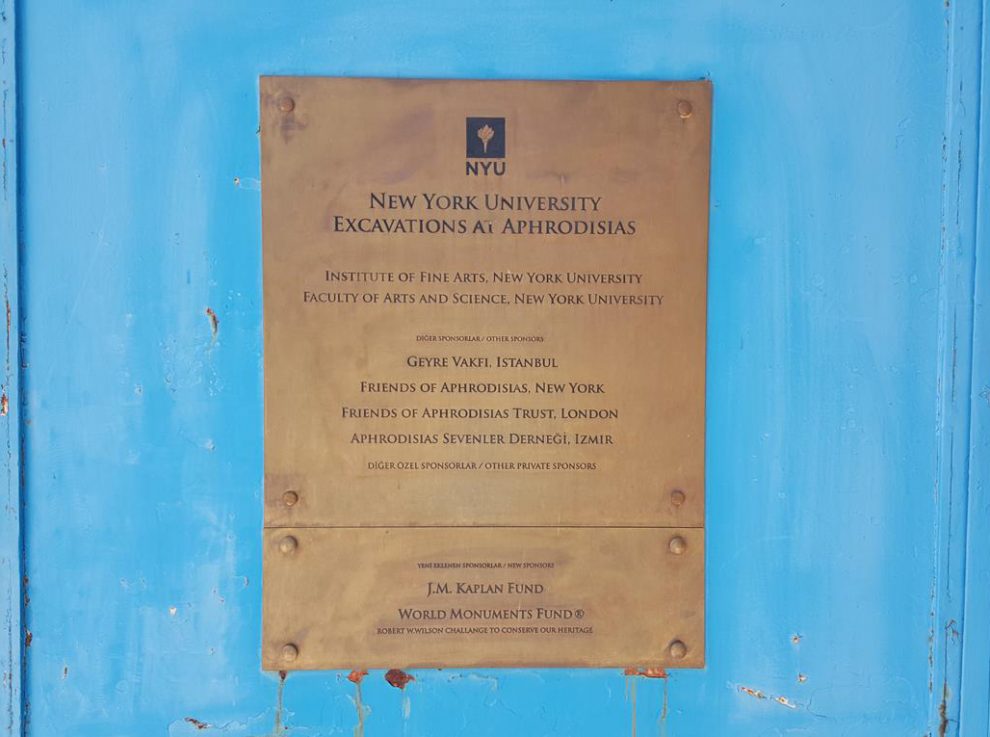
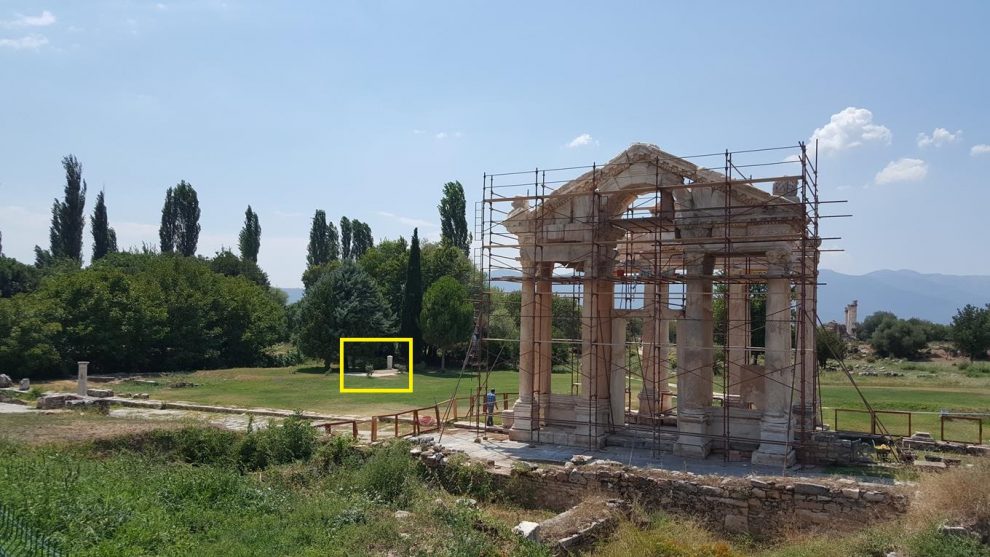
![]()
Aphrodisias (Afrodisias) Nostalji;
![]()



